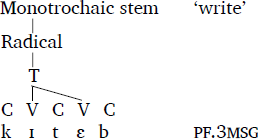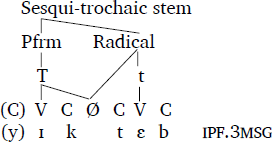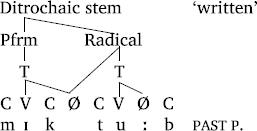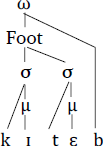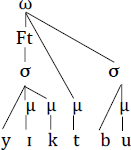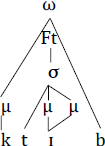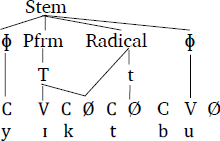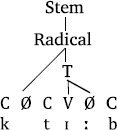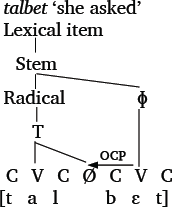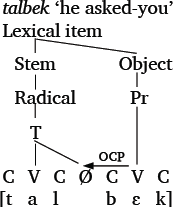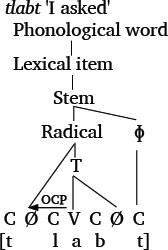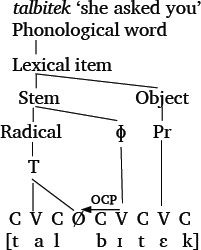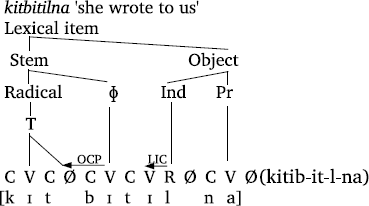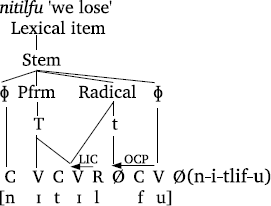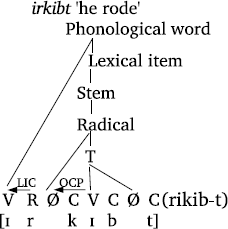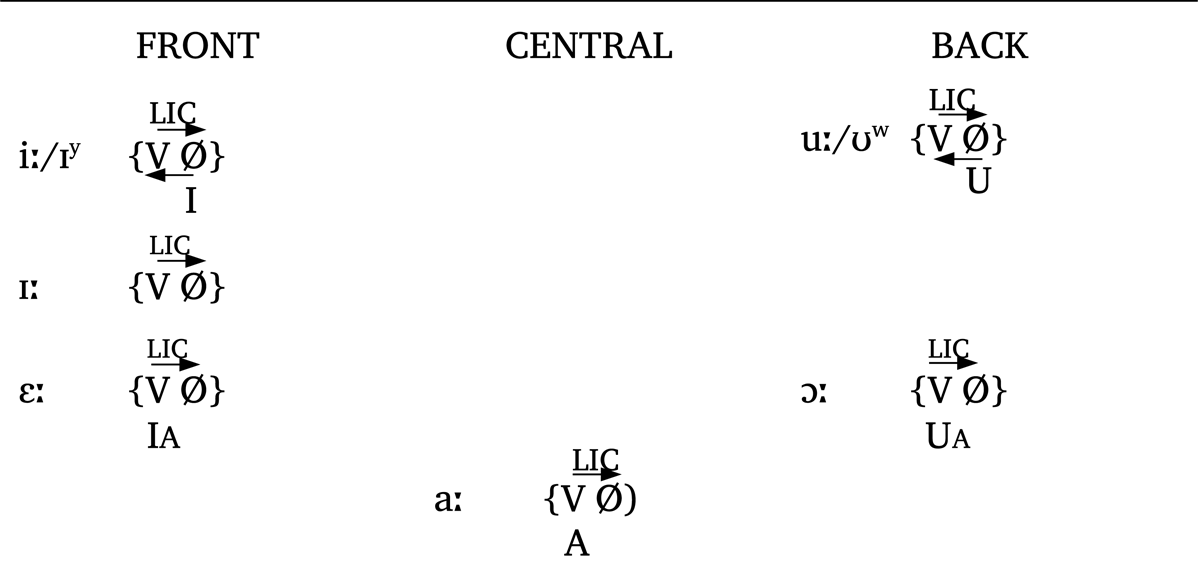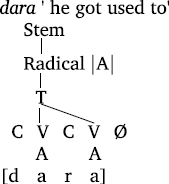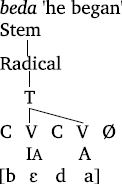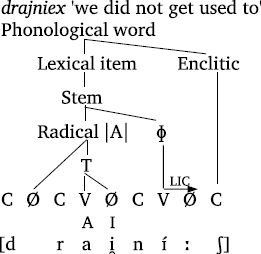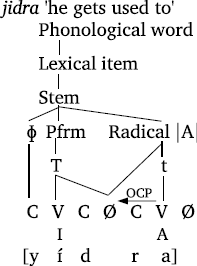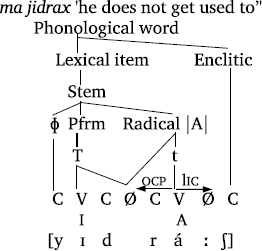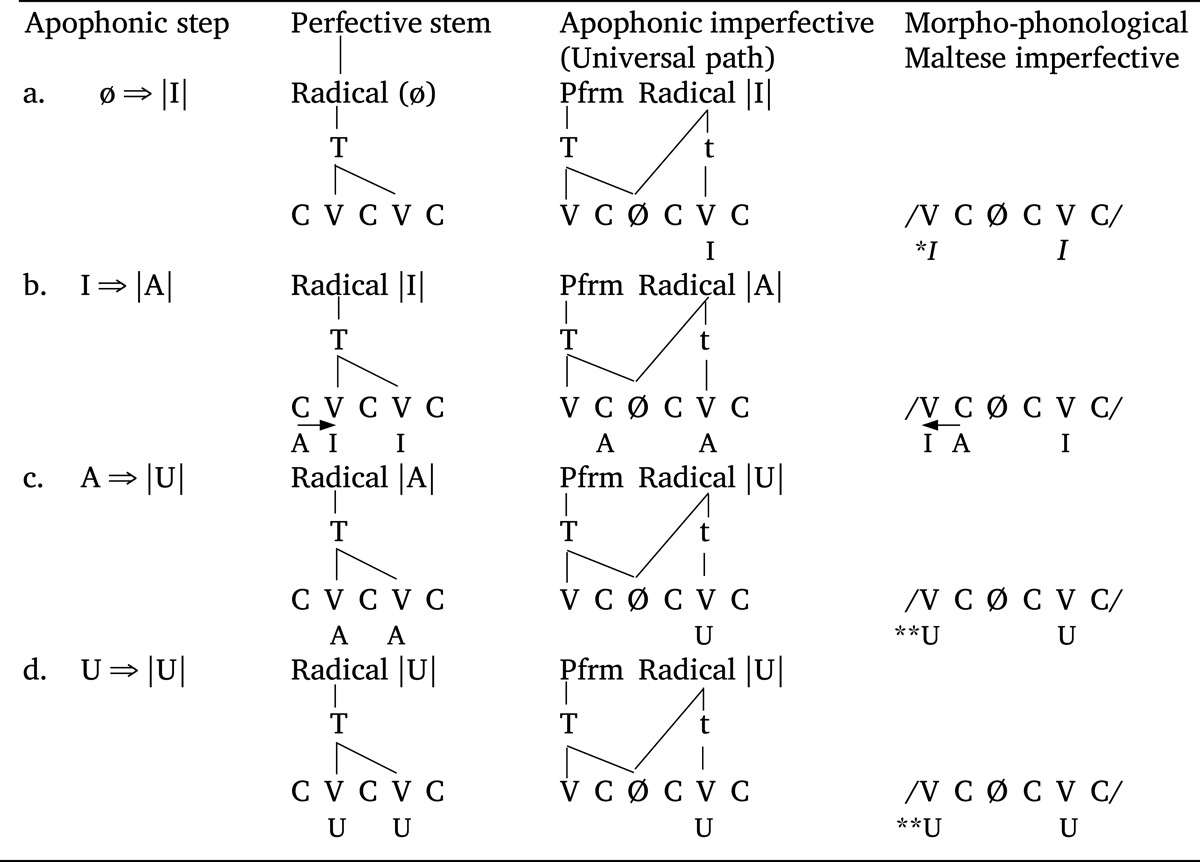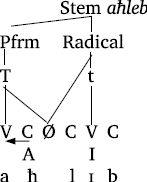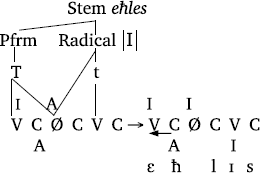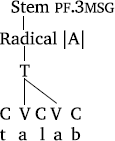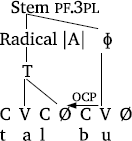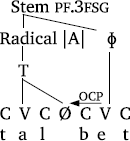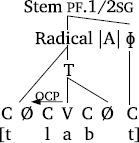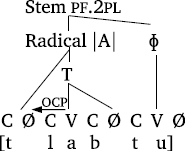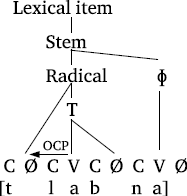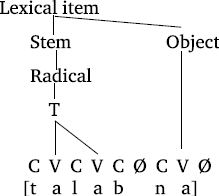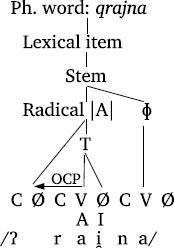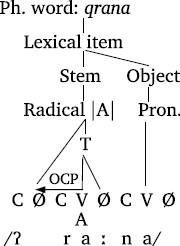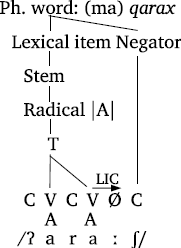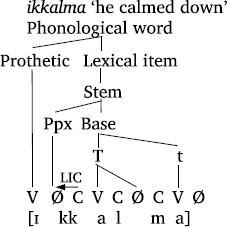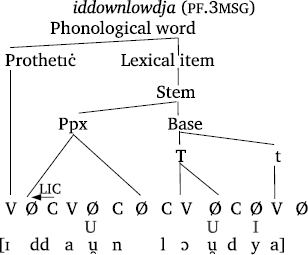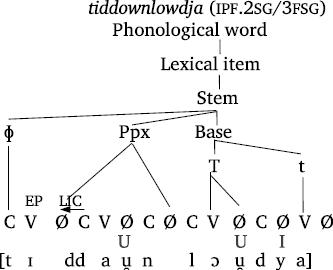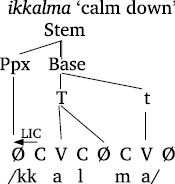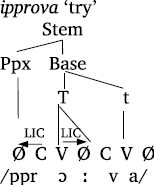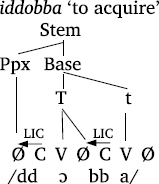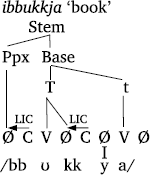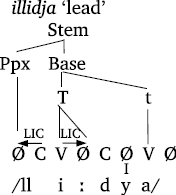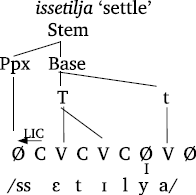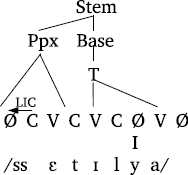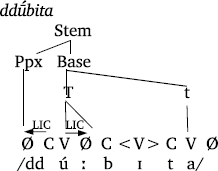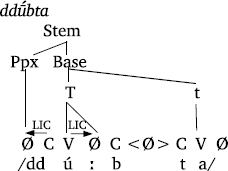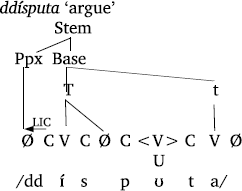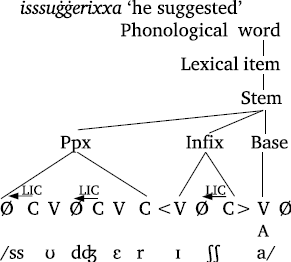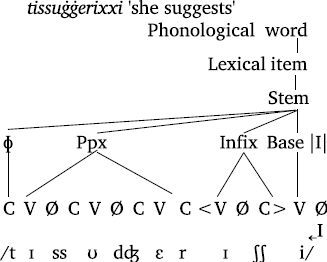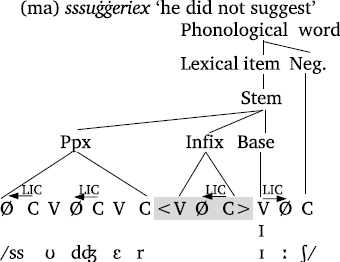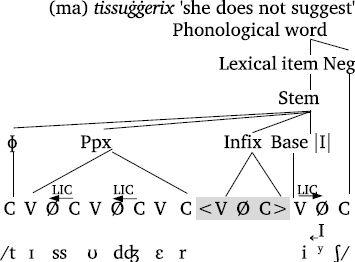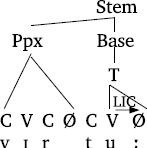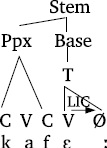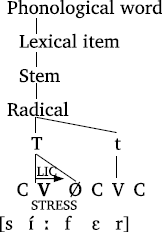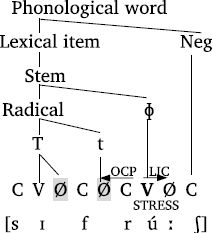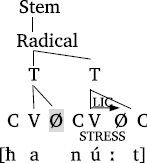1 Introduction
Maltese is the native language of a speech community of over 400,000 people in the sister-islands of Malta and Gozo. It is an offshoot of dialectal Arabic spoken in the 13th century on the islands under domination of Muslim rulers. After Malta was seized by Norman troops coming from Sicily, the islanders were converted to Christianity while keeping their Arabic idiom. Since that time, words to express new ways of life have been borrowed first from Sicilian, then from Italian under the rule of the Knights. After Malta became a British protectorate in 1800, English gradually competed with Italian and eventually superseded it in the school system. In the same time, under the influence of erudite educators, there was a movement toward standardization of Maltese, particularly aimed at promoting education among illiterate people. Italian remained a source of lexical borrowing for social interactions and legal matters. Since independence in 1964, English is the official language on a par with Maltese, “the national language” (Borg & Azzopardi 1997: xiv). Nowadays, the influence of (Maltese)-English is pervasive. Despite intermingling of populations, village dialects in Malta and Gozo are still practiced in family and local communities. For a comprehensive story of the Maltese language, see Brincat (2011).
The well-formed words that I take as examples in this paper have generally been checked in the ‘Maltese Language Resource Server’, referred to as Korpus Malti (KM); readers may thus look up in which context cited forms have been used. The paper is organized as follows. Section 2 presents generativist and OT contributions based on the interaction between stress assignment (of Palestinian Arabic type) and vowel syncope; dilemmas which these models have to face are analyzed. Alternatively, processing of embedded morpho-syntactic structures is implemented in three phases with eventual mapping of all exponents on the linearized segmental tier. In section 3, theoretical assumptions for a model of ‘Weak CV phonology’ are laid out. This model is distantly related to Strict CV Phonology (Lowenstamm 1996; Scheer 2004). Partly built on insights highlighted in Enguehard (2018) on “CV phonology without government”, my approach is based on universal principles of OCP and Licensing to shape stem syllabic profiles. Section 4 classifies the sounds of (Standard) Maltese and converts them into monovalent elements. The color of vowels is underlyingly specified or assigned by default in derivations; ‘reverse imāla’, which is crucial in Maltese synchronic phonology, is analyzed in this perspective. Section 5 is focused on template-bound verb stems (inherited from Arabic or fully assimilated), and section 6 on freely prepended templatic stems (more recent Maltesized loan-words). The issue of concatenative vs. non-concatenative morphology is briefly addressed. Maltese requires concatenative morphology only. After conversion or freezing of empty positions, main phonological processes are analyzed in section 7: first, stress assignment, correlated vowel length, and vowel quality in word-final position; then, neutralization of voice in a word-final obstruent, and voice agreement in obstruent clusters. The conclusion in section 8 highlights the main outcomes of this paper as a contribution to phonological theory and as overview of Standard Maltese phonology in a unified framework.
2 The cycle in Maltese phonology
In the introduction of his influential article Brame (1974: 39) aims at adducing evidence “supporting the hypothesis that stress rules apply cyclically in natural languages… Further examples give rise to a series of dilemmas, and the cycle proves to be an efficient technique for their solution and for the expression of a generalization that cuts across languages”.
Brame’s rule of Stress Assignment in Maltese interacts with a rule of syncope which deletes a short vowel in open syllable. The principle of cyclic interaction between Stress Assignment and Syncope was subsequently endorsed by Odden (1993) in lexical phonology, Hume (1994) in autosegmental phonology, and Borg (1997), then by Kiparsky (2011) in stratal OT, and by Wolf (2011; 2016) in Harmonic Serialism-Optimality Interleaving. I claim contradictorily that stress and syncope rules, as first formulated by Brame, give rise to several dilemmas for which cyclic derivations turn out to be an ‘inefficient’ technique.
2.1 Stress assignment and syncope in Brame (1972; 1974)
Brame (1974:44) claims that Palestinian and Maltese “developed from a common source” and that Maltese “stress patterns are strikingly similar to those of Palestinian”. Stress is assigned by the following rule:
- (1)
- Stress Assignment (SA): V→[stress]/— Cₒ((V C) V )]
Following SPE conventions, the rule says that primary stress is disjunctively assigned on:
antepenultimate V, in context: — CₒV C V ]
penultimate V, in context: — Cₒ V ]
else on ultimate V, in context: — Cₒ ]
The Syncope rule (1974:44) is formulated as:
- (2)
- V̆→Ø/—CV
Table 1 illustrates the interaction between stress and syncope. In the perfect aspect, the 3msg form is expressed by the (suffixless) bare stem; an inflectional ɸ-suffix is adjoined to the stem in 3fsg, 1/2sg, and plural forms. The vowel suffix of plurality -u is adjoined on the second cycle only. Stress is antepenultimate when the stem is followed by a vowel, and penultimate in other cases. Syncope applies on the second cycle after stress reassignment; thus, the 1st cycle antepenult stress eventually surfaces on the penult.
Conjugation of ħataf ‘grab’ in the perfect (Brame 1972; 1974: 45).
| 3msg | 3fsg | 1sg | 1pl | 3pl | |
| First cycle | ħataf | ħataf+et | ħataf+t | ħataf+na | ħataf |
| Stress | ħátaf | ħátaf+et | ħatáf+t | ħatáf+na | ħátaf |
| Second cycle | ħátaf+u | ||||
| Stress | idem | idem | idem | idem | idem |
| Syncope | ––––– | ħátf+et | ħtáf+t | ħtáf+na | ħátf+u |
| Surface form | [ħátaf] | [ħátfet] | [ħtáft] | [ħtáfna] | [ħátfu] |
Stress is primarily assigned on the 1st cycle, and reassigned on the 2nd cycle; if the primary stress is shifted rightward, it becomes secondary according to SPE conventions, as shown in (3).
- (3)
- Stress shift:
- First cycle
- Stress:
- Second cycle
- Stress:
- talabna ‘he asked us’
- talab
- tálab
- tálab+na
- tàlábna
If a reduced stress “is not actually present in phonetic representations, it may be eliminated by postulating an additional rule” (Brame 1974: 44). Be as it may, Kiparsky (2011: 5) rightly observes that in Maltese a cyclically-generated “secondary stress is not vouched in any description”.
Brame (1972:29 and footnote 9) builds the imperfect conjugation of canonical stems (CVCVC in the perfect) on a ‘CV+CCVC’ template; the initial consonant is a person prefix followed by a prefixal vowel (i by default), then a -CCVC/CCC stem-template.
- (4)
- a.
- b.
- ni+kteb
- ni+ktb+u
- ‘I write’
- ‘we write’
In (4b) the deletion of the stem vowel, required by the Syncope rule in (2), generates a CCC cluster. (5b) is substituted to (4b) if the medial root-consonant is a liquid or nasal sonorant (R), since Maltese prohibits CRC-clusters.
- (5)
- a.
- b.
- ni+tlef
- ni+tilf+u
- ‘I lose’
- ‘we lose’
Brame accounts for plural forms in (5b) by a metathesis rule, whereby CRVCV is changed into CVRCV, thus preventing a CRC cluster. Metathesis bleeds Syncope on the second cycle; the secondary stress, eventually erased by a late rule, prevents Syncope from applying to the prefixal vowel. This strategy implies that the plural marker -u is introduced on the second cycle, as shown in Table 1, and in (6).
- (6)
- First cycle
- Stress Assignment
- Second cycle
- Metathesis
- Stress Assignment
- Syncope
- Surface form
- ni+tlif
- ní+tlif
- nítlif+u
- nítilf+u
- nìtílf+u
- –––––––
- [nitílfu]
An object pronoun is indeed expected to be adjoined on the second cycle; in (3) for instance, [tàlábna] ‘he asked us’ is a compositional function of the singular [talab] and the suffixed object pronoun [-na]. But, as rightly observed by Brame (1974: 58), to what extent can we claim that (4b) ‘we write’ and (5b) ‘we lose’ are a compositional function of ‘I write’/‘I lose’ plus ‘plural’? Thus, placing the plural morph not in the 1st cycle with subject pronouns, but in the 2nd cycle with object pronouns lacks strong support.
Furthermore, in the perfect aspect the derivation fails in cases like difnítu ‘she buried him’ (example borrowed from Hoberman 2007: 259) or talbítek ‘she asked you-sg’. According to SA in (1), stress is assigned to the antepenult on both cycles; in the second cycle, Syncope incorrectly deletes the inflectional vowel:
- (7)
- First cycle
- Stress Assignment
- Second cycle
- Stress Assignment
- Syncope
- difin+it
- dífinit
- dífinit+u
- dìfínitu
- *dìfíntu
- talab+it
- tálab+it
- tálabit+ek
- tàlábitek
- *tàlábtek
If the application of Syncope is restricted to stem vowels, the derivation would still fail, yielding *dìfínitu/*tàlábitek, with wrong placement of primary stress on the antepenult.
2.2 Syncope underapplication in ‘weak’ verb conjugation
V-ending stems are traditionally classified as ‘weak’ in contrast to ‘C-ending ‘strong’ stems. Odden (1993) was the first linguist to raise the issue of syncope overapplication in weak stems.1
The first stem vowel is stressed if the weak verb is suffixless, and the second vowel is realized short (no word-final long vowel in Maltese except in a few monosyllabic irregular verbs like ġie ‘he came’ or nouns like kafè ‘coffe’). The 3msg object pronoun exponent is -h (pronounced as laryngeal [h] or pharyngeal [ħ]) after a long vowel, e.g. kitbuh [kɪtbúːħ] ‘they wrote it-msg’. Consider the following weak finite forms:
- (8)
- a.
- b.
- qara
- qrah
- [ʔára]
- [ʔráːħ]
- ‘he read’
- ‘he read it’
- kera
- krieh
- [kɛ́ra]
- [krɪ́ːħ]
- ‘he hired’
- ‘he hired it’
Since in cyclical derivations the object pronoun is introduced in the second cycle, one would expect the first stem vowel to be prevented from syncopating by prior application of stress in the first cycle. Thus, within a model of interaction between modules in lexical phonology, Odden (1993: 116) proposes a precompilation rule “to keep cyclicity and level ordering, without interaction between phonology and morphology”:
the Level 1 phonology will generate both ʔara and ʔaraa. The former leaves Level 1 as ʔára and the latter leaves Level 1 as ʔráa… So, when a negative or object affix is concatenated in Level 2, the variant ʔráa is selected (p. 141).
Notice first that the case with a negative suffix should be kept distinct from the case with an object pronoun: the frame ʔráa is precompiled for the latter but a third frame ʔaráa should also be precompiled to account for the negative form, e.g. ma qarax [ma ʔaráːʃ] ‘he did not read’. Thus, there are three (italicized) stem allomorphs:
- (9)
- a.
- b.
- c.
- qara
- qraː-na
- qaraː-ʃ
- [ʔára]
- [ʔráːna]
- [ʔaráːʃ]
- ‘he read’
- ‘he read us’ (source: Odden 1993: 141)
- ‘he did not read’ (147 examples in KM)
Application of syncope in the conjugation of weak verbs is a serious issue for Brame’s cyclic model. Borg (1997: 271) is faced with the same problem. The author generates flieh [flɪ́ːh] ‘he scrutinized him’ from [fɛlɪː+h], but one may wonder how his model may generate ma feliex ‘he did not scrutinize’ (KMsport1651). For Wolf (2016: 361), underapplication of syncope in negated weak verb forms “suggests that the first stem vowel is protected by virtue of having been assigned stress ‘cyclically’ prior to the suffixation of /-ʃ/”. Wolf’s OT model implies “local ordering of phonology and morphology” within cycles. For Kiparsky (2011: 4) “a common feature of Odden’s and Wolf’s theoretical proposals is their hybrid character: a precompilation rule quacks like phonology but walks like allomorphy, OT-CC/OI quacks like OT but walks like old-time stipulative rule ordering”.
2.3 Allomorphy of 3msg object pronoun
The allomorphic choice of the exponent of the 3msg object pronoun is yet another problem. After a consonant, the exponent of the pronoun is -hu if it is followed by a second object in indirect construction, elsewhere it is -u. Borg refers to Brame for whom “Since cyclic rules are dependent on bracketing, it seems natural to constrain the cycle by placing constraints on where brackets can occur” (Brame 1974: 58). For instance, Borg (1997: 272) generates <ma sraqnihilhiex> ‘we did not steal it-fsg from her’ from [ma[[[sraʔnaː]haː]l-haː]ʃ], where each bracketed suffix (object pronouns and negative morph) initiates a cycle. The point, however, is that material in the 3rd cycle is not visible from the 2nd cycle; thus, when the stem is followed by the 3msg object suffix, the allomorphic choice between -u in (10a) and -hu in (10d) may not be determined in the 2nd cycle.
- (10)
- a.
- b.
- c.
- d.
- e.
- [[seraq]u]
- [[[seraq]ū]x]
- [[seraq]ek]
- [[[seraq]hū]l-i]
- [[[seraq]hom]l-i]
- ‘he stole it-msg’
- ‘he didn’t steal it-msg’
- ‘he stole you’
- ‘he stole it-msg from me’
- ‘he stole them from me’
- serqu
- serqux
- serqek
- seraqhuli
- seraqhomli
2.4 Antepenult stress in loan-words
Loan-words with surfacing antepenult stress are well integrated into the lexicon of contemporary Maltese. In Aquilina’s words (1987: Guide to the Dictionary, Accent: 14.1)
In Romance Maltese and in English loan-words the accent retains the position it has in the original language when it is pronounced by educated people but otherwise conforms to the rule of Semitic Maltese discarded in the written language as rustic forms. Exx. mùżika ‘music’ with the stress on the first syllable pronounced as in Italian ‘musica’ ‘music’ but mużìka with the accent on the second syllable as in Semitic Maltese. Similarly Àfrika ‘Afrika’/Afrìka <It. Afrika, màniġer ‘manager’ manìġer <Eng. manager. [the grave accent marks word stress in this citation].
According to Mifsud (1995: 194) “Although proparoxytones do not feature in the traditional repertory of SM [Semitic Maltese] prosody, they can now be considered to form an integral part of the stress patterns of modern M[altese]”. Borg (1997: 279) assesses that Maltese morphophonology integrates systemic doublets: “in reflexes of certain recently borrowed Italian proparoxytones M[altese] speakers tend to hesitate between a native stress pattern and the Italian one: /fertíːli ~ fértili/ ‘fertile’ < It. [fértili]”.
To conform to existing stress patterns, etymologically proparoxytone stems syncopate a vowel, e.g. órdna ‘order’ <It. [órdina], or lengthen the penult and shift the accent, e.g. applíːka ‘apply’ <It. [ápplika]. Thus, at an earlier stage, proparoxytone loan-stems were ‘Maltesized’ as paroxytone; more recently in acrolectal registers, speakers preserve etymological stress in proparoxytone loan-words while underapplying Syncope. In either case, Brame’s rules, intended for Semitic Maltese, cannot faithfully account for this class of loan-stems, whichever variant is chosen.
2.5 Recapitulative remark
In cyclic models which have been implemented for Maltese, if stress is assigned to the underlying antepenult vowel in the first cycle; a syncope rule, which applies in the second cycle (Brame 1972; 1974) or is itself cyclic (Hume 1994) then deletes a short unstressed penult vowel in a light syllable. Derivations are organized in two cycles only (Brame 1972; 1974) or in as many cycles as suffixal morphemes (Borg 1997); in Hume (1994: 201) postcyclic and postlexical processes also apply after the second cycle. I have argued that these approaches yield unfaithful derivations and do not prove “to be an efficient technique”, to use Brame’s terms, to solve dilemma in allomorphic choices. They also mask a generalization expressed by Hoberman (2007: 259) in simple terms:
Word stress is generally predictable from syllable structure: a final superheavy syllable is stressed; otherwise word stress is on the penultimate syllable … Exceptions are marked: virtù ‘virtue’, elèttriku ‘electric’.
Finally, note that in suffixed forms of proparoxytone borrowed stems, stress is always (pen)ultimate. In section 7.2, I propose post-lexical formulation for word-stress assignment; see also Aquilina (1959), Cohen (1966), Fabri (2009), Puech (2011), Camilleri (2014).
2.6 Alternative organization in phases
The phonological cycle “embodies the insight that (phonological and semantic) interpretation applies successively from the most to the least embedded piece of structure” (Scheer & Cyran 2018: 294). Keeping up with this insight, derivations are organized in three ‘phases’.
Stems are built in the pre-lexical phase. Their morphological head is a Radical morph, which may be preceded by a preformative morph. In the imperative mood and imperfect tense/aspect of canonical CVCVC perfect verbs, a preformative vowel (Pfrm) precedes the Radical. A stem is subject to wellformedness constraints. Bare stems must be parsed as monotrochaic (binary trochee T) as in (11a), sesqui-trochaic (binary trochee+degenerate trochee) as in (11b,c), or ditrochaic as in (11d); see Hayes (1995) on degenerate trochees.
Firstly, T heads a full vowel V, and the dependent branch may be V or Ø; cf. 3.1.2. Underlyingly, t heads a full vowel V also. Secondly, the prosodic stem must be minimally monosyllabic and maximally disyllabic, which implies that it includes one V at least, two Vs at most. Constraints on stem trochaicity and syllabicity interact. It follows that in sesqui-trochaic stems, the T dependent branch is an empty position (Ø) as in (11b,c,d), and that in ditrochaic stems as in (11d) the dependent branch of both Ts is an empty position.
- (11)
- Prosodically well-formed stems
- a.
- b.
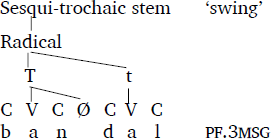
- Stems headed by a preformative vowel (Pfrm):
- c.
- d.
- (12)
- Underlyingly ill-formed stems
- a.
- b.
- c.
- d.
As in Arabic, there are segmental constraints of wellformedness: radical consonants may not share the same place of articulation; cf. Greenberg (1950). For Maltese, Spagnol & Mayer (2010) give “an exhaustive list of 1,958 verb-creating roots” confirming avoidance of similar place of articulation among obstruents, and between liquids.
As shown in Table 2, stems are built in the Pre-lexical phase. Forms are inflected by ɸ-features for agreement in person (1/2/3), genre (m/f) and number (sg.l). As observed by Lowenstamm (2011: 152) “there is overwhelming evidence of interaction between the ultimate shape of the Semitic stem and the makeup of its accompanying inflection”. In particular, a radical nucleus followed by a ɸ-morph may be downgraded (V→Ø).
Lexical items are built in the second phase. The head of the Lexical item domain is the stem; its dependent branch is a pronominalized object, in direct or indirect construction. The Object morph is a pronoun whose features agree with the syntactic/semantic object; in indirect construction, particle /l/ of indirection is prepended. In ditransitive stems, a second Object pronoun may be added in indirect construction, in which case the pronoun of the first direct Object is obligatorily in the 3rd person (m/f, sg/pl), while indirect Object 2 (not coreferential) agrees freely in person, genre and number; cf. Borg & Azzopardi (1997), Sadler & Camilleri (2013). The second object appears thus to be in the dependence of the first one, which phonology confirms; in particular, an epenthetic i is never inserted between the first object pronoun hom and the indirection /l/ preceding the 2pl object pronoun, e.g. fetaħ-hom-l-kom ‘he opened them for you’ (cf. Borg & Azzopardi 1997: 361).
Phonological words are built in the postlexical phase. Clitics are concatenated. Auxiliary (pseudo)verbal forms, negative particle ma, prepositions, definite article and demonstratives are proclitic; the negator (orthographic x) is enclitic; cf. Borg & Azzopardi (1997), Wilmsen (2011). All morph exponents are eventually linearized on the segmental tier. Empty positions are converted or freezed, i.e. made invisible, before phonological processes apply to surface forms. Main processes are: word-stress assignment, vowel length and quality, unvoicing of word-final obstruent and voice agreement in obstruent clusters.
Readers may rightfully wonder what makes this organization in phases different from an organization in cycles. Cyclic models of (post)generative and OT phonology are based on the application of the same rule(s) on different cycles, in particular Stress Assignment and Syncope. In the present model embedded pieces of structure are processed in different phases but a rule/constraint is operative in one phase only. For instance, a radical nucleus will be shown to be downgraded by OCP or upgraded by Licensing in the Lexical phase, but not in the pre- or post-lexical phase; word-stress is assigned on the post-lexical phase only. For complementary views on phases and cycles, see Embick (2010; 2014).
An anonymous reviewer doubts that the preformative vowel forms part of the stem: “Being phonologically required need not imply that it does have to become part and parcel of the templatic CCVC, for instance”. I will first address this issue.
2.6.1 Incorporation of the preformative vowel in the stem
The reason why the preformative vowel is part and parcel of the stem is first morphological, and secondarily confirmed by phonology. Verbs whose stem template in the perfect is CVCVC build their imperfective forms (imperative mood and imperfect tense/aspect) with a preformative vowel and contiguity of the first two radical consonants, that is V-CCVC.
- (13)
- a.
- b.
- pf.3msg
- kiteb
- ħadem
- imp.sg
- ikteb
- aħdem
- ipf.1sg
- n-ikteb
- n-aħdem
- ‘write’
- ‘work’
For imperative forms in (13) I see no reason why the initial vowel should be epenthetic (or prothetic) since initial CC clusters are well-formed in Maltese, e.g. ktieb ‘book’. The alternative hypothesis is an underlying morph, which surfaces as i by default, or a in (13b) by guttural assimilation, see Hume (1994: 207). Verbs whose stem template in the perfect includes a long vowel or a geminate consonant have their imperfective forms without preformative vowel; in the imperfect tense/aspect the ɸ-prefix is in direct junction with the first radical consonant. The perfect, imperative and imperfect forms are shown in (14), and in (15) for verbs in measure 9 (template CCV̅C), cf. Borg & Azzopardi (1997: 370).
- (14)
- a.
- b.
- c.
- d.
- dār
- mess
- kisser
- bierek
- dūr
- miss
- kisser
- bierek
- n-dūr
- (i)m-miss
- n-kisser
- m-bierek
- ‘turn’
- ‘touch’
- ‘break into pieces’
- ‘bless’
- (15)
- a.
- b.
- c.
- ħdār
- ħdār
- ni-ħdār
- ‘turn green’
All Radicals in (14) and (15) are trochaic; in (15c) a vowel is inserted between the prefix ɸ and the first radical consonant. The imperative form proves that this is not a preformative vowel. In fact, Maltese does not allow the formation of word-initial CCC clusters,2 as the junction of the ɸ-prefix to a stem-initial underlying CC cluster would yield. An epenthetic vowel is thus inserted, but this vowel does not undergo guttural assimilation, contrary to the preformative vowel; cf. Hume (1994: 210). In my approach, the preformative vowel is the head of the stem trochee. The epenthetic vowel in (15c) in contrast is prepended to the trochaic Radical. Similarly, we will see in section 6 that in borrowed vocabulary, characterized by a lexical prependix, the head of the stem trochee is on the radical base.
2.6.2 Exponent of the 3msg object pronoun
A list of ditransitive verbs is given in Sadler & Camilleri (2013: Appendix). When these verbs are built with two object pronouns, the first one in direct construction is obligatorily in the third person (singular/plural, masculine/feminine); the second is preceded by the indirection particle /l/. After consonant, the 3msg object pronoun has two (orthographic) exponents: u or hu. Reduced u exponent is selected if the object pronoun ends the Lexical item domain; full exponent hu is selected when the direct 3msg object is followed by the indirection particle and an Object 2 pronoun; cf. conjugation of fetaħ in Borg & Azzopardi (1997: Appendix, 358–361).
- (16)
- a1
- b1
- c1
- d1
- fetħu
- talbu
- fetaħhuli
- talabhuli
- ‘he opened it’
- ‘he asked it’
- ‘he opened it for me’
- ‘he asked it to me’
- a2
- b2
- c2
- d2
- ma fetħux
- ma talbux
- ma fetaħhulix
- ma talabhulix
- ‘he did not open it’
- ‘he did not ask it’
- ‘he did not open it for me’
- ‘he did not ask it to me’
In (16a,b) the 3msg object pronoun is at the right edge of the Lexical item domain; the reduced exponent -u triggers syncope of the 2nd radical vowel. In (16c,d) the full exponent, spelt hu or simply u (e.g. KMparl9113), is internal in the Lexical item domain and prevents radical vowel syncope. Compare this approach with cyclic analysis in 2.3.
3 Theoretical assumptions
I adopt an approach which I dubbed ‘Weak CV Phonology’; it is distantly related to a family of models known as Government Phonology, initiated by Kaye, Lowenstamm & Vergnaud (1990), Strict CV Phonology (Lowenstamm 1996), or CVCV Phonology (Scheer 2004).
3.1 Syllabic structures
According to Lowenstamm (1996: 24), syllable structure universally reduces to CV:
for all languages closed syllables, geminate consonants, and long vowels must be reanalyzed in terms of sequences of light open syllables.
3.1.1 Syllabic structures in Strict CV Phonology
Pseudo-words in (17) provide different configurations which are reanalyzed in Strict CV phonology: closed syllables, geminate consonants, and long vowels.
- (17)
- Reanalysis of syllables in Strict CV Phonology
- Ia.
- b.
The word [takti] is reanalyzed “as a sequence of three light syllables, the second of which has an empty nucleus”.
- IIa.
- b.
The salient feature in IIb. is “the presence of the V position straddled by the geminate”.
- IIIa.
- b.
In IIIb. “the vowel links up to both nuclei and straddles an intervening empty onset”.
3.1.2 Syllabic structures in Weak CV phonology
Weak CV Phonology supports the view that each position occupies a slot that is either filled by a consonant (C) or a vowel (V), or remain empty (Ø). Each V-slot, and only a V-slot is a syllabic center. The obligatory contour principle (OCP) prohibits identical contiguous positions; thus, *VV, *CC, or *ØØ are not allowed. The representation of long vowels and geminates is analyzed in 3.3.3 and 3.3.4 respectively.
In Weak CV Phonology, the universal CV kernel of syllables may be complemented provided that OCP is not breached; ‘CVC’ is thus a well-formed syllable. The onset position may be occupied by a prothetic glottal stop in lexically V-initial words, e.g. omm [ʔɔmm] ‘mother’; cf. Borg & Azzopardi (1997: 301). Maltese allows word-initial and word-final ‘CØC’ clusters, e.g. ktibt ‘I wrote’, and intervocalic ‘CØCØC’ clusters, e.g. niktbu ‘we write’. The enclitic negator x may be appended to finite verbs, and some nominal forms, allowing ‘CØCØC’ word-final clusters, e.g. ma ktibtx ‘I did not write’.
A consonant (C) may represent an obstruent or a sonorant. In phonological contexts where it is necessary to distinguish a sonorant from an obstruent, the former is represented by R. Weak CV Phonology endorses the view that lateral relations encode the “labour of syllabification”. According to Scheer & Cyran (2018: 263):
Syllable structure is a function of two and only two factors: the order of segments in the linear string and their sonority with respect to their neighbours.
On the UG scale of sonority, ‘obstuents<sonorants<vowels’. In 4.2 below, this is based on the phonological representation respectively assigned to obstruents, sonorants, and vowels. In Maltese, a constraint of well-formedness requires a position to be filled by a vowel at the left of a sonorant followed by an empty position at its right; similarly, a prothetic vowel is inserted if a preceding word or a proclitic morph does not end in a vowel, cf. below (24c).
- (18)
- a.
- b.
- Word-initial
- Word-internal:
- RØCV
- CØRØCV
- →
- →
- iRØCV (prothetic vowel in italics)
- CiRØCV (epenthetic vowel in italics)
On a phonetic basis for sonority, see Clements (2009). For complements and more examples on syllabic structures in Maltese, readers are referred to Borg & Azzopardi (1997: 306ff), Fabri (2009), Puech (2011), Camilleri (2014: 47ff), and Galea & Ussishkin (2018).
3.2 Weak layering in prosodic hierarchy
Within the broad program of Prosodic Morphology initiated by McCarthy and Prince (1990) the ‘Strict Layering Hypothesis’ assumes that a foot dominates syllables, and a syllable dominates moras. Under the ‘Weak Layering Hypothesis’ a mora is not necessarily dominated by a syllable, nor a syllable by a foot; cf. Ito & Mester (2003). For instance, Kiparsky (2003:154ff) claims in his moraic analysis of Arabic dialects (Maltese included) that moras may be prosodically licensed by adjunction to a superordinate prosodic category. In (19a&c) the word-final consonant is directly linked to the non-metrical node ω, being thus ‘extrametrical’. In (19a) the foot is linked to two syllables, and each syllable to a mora; in (19b&c) the foot is linked to one syllable branching on two moras. In (19c) the long vowel is represented as bimoraic; the initial consonant is attached to a prepended mora (weak layering). Kiparsky analyzes this configuration as ‘sesquisyllabic’.
- (19)
- Representation of kiteb ‘he wrote’, jiktbu ‘they write’, and ktieb ‘book’ after Kiparsky
- a.
- b.
- c.
In Weak CV Phonology, there is no autonomous σ-level and μ-level of representation. The model makes a distinction between actual syllables, whose center is V, and potential syllables, whose nuclear position is empty. Actual syllables correspond to the σ level in most frameworks. An onset precedes the syllabic nucleus. What corresponds to a coda is here analyzed as a potential onset; a word-final position, extrametrical in (19), is also a potential onset. Prosodic scansion as in (11) dispenses with the moraic level. The trochee’s head-branch is linked to V, and dependent branches to V or Ø.
- (20)
- Representation of kiteb, jiktbu, and ktieb in Weak CV Phonology
- a.
- b.
- c.
Compared with representations in (19), (20a) is monotrochaic & disyllabic, (20b) is sesqui-trochaic & disyllabic; (20c) is monotrochaic & sesquisyllabic (prepended empty position).
3.3 Lateral ‘forces’
Lateral forces of ‘government’ and ‘licensing’ are the hallmark of CVCV phonology:
Government is assumed to be a relation that diminishes melodic material under the affected position. Thus, it may be viewed as a negative or destructive force. Licensing, on the other hand, supports melodic structure. It is a positive force” (Scheer & Cyran 2018: 273).
Government implies a lateral relation which reduces a vowel V to an empty position Ø:
- (21)
I will, however, partially follow Enguehard (2018) who suggests to broaden the definition of OCP in a framework of “Strict CV without government”.
As formulated by McCarthy (1986: 208) the Obligatory Contour Principle prohibits “adjacent identical elements”. It has already been proposed in 3.1.2 that in Weak CV Phonology OCP prohibits CC, VV, and ØØ strictly contiguous sequences. OCP may also interact at a distance to “prevent a succession of identical vowels in adjacent nuclei”, cf. Enguehard (2018: 33, and references therein). In Maltese, a radical vowel is reduced to an empty position if it is followed by CV, where V is itself radical or suffixal. (21) may thus be reinterpreted as in (22):
- (22)
OCP acts at a distance as a dissimilative force.
3.3.1 Dissimilative OCP in Maltese
In (23a) the vowel of inflectional suffix -et dissimilates the second nucleus of talab ‘ask’; in (23b) this nucleus is dissimilated by the vowel of the object pronoun -ek; in (23c) the second radical nuclear position dissimilates the first radical nucleus. Crucially in (23d) the vowel of the object pronoun in talb-it-ek ‘she asked you’ cannot target the inflectional vowel, which by definition is not radical, but the inflectional vowel dissimilates the radical vowel to its left; cf. contra wrong application of Brame’s syncope rule in (7).
- (23)
- OCP-dissimilation of a radical nucleus
- a.
- b.
- c.
- d.
3.3.2 R-Licensing (epenthetic/prothetic vowel in the stem domain)
Maltese requires a liquid or nasal consonant to be preceded or followed by V, else an empty nucleus at the left of the sonorant is ‘licensed’ as vowel. An epenthetic vowel is thus inserted within and at the right edge of the stem domain; 3 a prothetic vowel is attached to the left edge of the Phonological word domain in similar context. Licensing may be viewed as an assimilative force insofar as a sonorant liquid or nasal is more ‘vocalic’ than an obstruent.
- (24)
- Licensing of an epenthetic/prothetic vowel
- a.
- b.
- c.
3.3.3 Vowel length
In weak CV Phonology, V may be followed by an empty position. A word-final empty position is ‘invisible’, cf. 7.1. An empty position is interpreted as length iff it is licenced by the vowel bearing word-stress, cf. 7.2.
- (25)
- a.
- b.
- c.
In (25) the stressed vowel licensing an empty position is realized long. In (25b) the vowel followed by a word-final ‘invisible’ empty position is realized short; word-stress is penultimate. In (25c) the first V followed by an empty position is realized short since it is followed by the vowel bearing word-stress; cf. McCarthy (2005) for vowel length in Arabic.
3.3.4 Consonant gemination
Geminate consonants are represented by an empty position licenced by right-contiguous C.
- (26)
- a.
- b.
- c.
In (26a) phonetic cues pointing to the word-final geminate are distributed over the (lengthened) vowel and the consonant itself; cf. Galea (2016). In (26b) the representation guarantees the integrity and inalterability of the geminate, since no epenthetic material may be intercalated between Ø and C; cf. Hayes (1995). In (26c), the negator (orthographic x) is adjoined to firex ‘spread; the stem-final consonant and the enclitic are separated by an empty position; the representation of this bogus-geminate is thus different from stem-geminates. On geminates and OCP, see Rose (2000); for alternative views on the empty nucleus in the expression of long vowels and geminates, see Russo & Ulfsbjorninn (2017).
4 The sounds of (Standard) Maltese
I first set up the inventory of phonetically contrastive consonants and vowels in Standard Maltese. Then, these sounds are analyzed into monovalent elements: |C| and |V| for stricture, and |I|, |A|, or |U| for color (melodic elements).
4.1 Phonetic inventory
4.1.1 Consonants and glides
IPA symbols for consonants and glides are classified in Table 3 according to manner and place of articulation. They are distributed into two major classes: obstruents (oral stops, fricatives, and affricates), and sonorants (nasal stops, lateral liquid and rhotic); when they are realized as oral approximants, glides pattern with consonants. There are four major places: Labial, Coronal, Dorsal, and Guttural.
Maltese consonants and glides.
| consonants: | labial | coronal | dorsal | guttural | |||||
| bi-labial | labio-dental | alveolar | post-alveolar | pal-atal | velar | post-velar | pharyn-geal | glottal | |
| stops | p/b | t/d | k/g | ʔ | |||||
| fricatives | f/v | s/z | ʃ ʒ | [χ] | ħ | [h] | |||
| affricates | ʦ ʣ | ʧ ʤ | |||||||
| nasals | m | n | |||||||
| lateral | l | ||||||||
| rhotic | r[ɾ] | ||||||||
| approximants | w | y | |||||||
Voice is contrastive in obstruents functioning in pairs, but neutralized in some contexts. Pairs of obstruents are: p/b and f/v, t/d and s/z, and k/g. In these pairs, the voiceless member is realized by its voiced counterpart in voicing contexts, and conversely. Voiceless and voiced post-alveolar fricatives and affricates do not function in pair. Guttural obstruents are voiceless only. Depending on contexts and speech habits, the guttural fricative is realized as post-velar [χ], pharyngeal [ħ] or laryngeal [h]. Aquilina (1959) represents this set of allophones by pharyngeal /ħ/; [Alexander] Borg (1997), [Albert] Borg & Azzopardi (1997), and others, consider that the symbol for laryngeal frictionless /h/ is more appropriate in contemporary Standard Maltese. I adopt the ‘neutral’ representation /ḥ/. The frequency of occurrence of some fricatives or affricates is low; but their contrastive status is well established through frequent words, e.g. [ʦɔ́kkɔr] zokkor ‘sugar’ for /ʦ/, [tɛlɛvɪ́ʒin] ‘television’ for /ʒ/, [gadʣɛ́tta] ‘newspaper’ for (simple or geminated) /ʣ/.
Depending on context and speech habits, the (geminate) rhotic /r/ is realized as trilled [r] or flapped [ɾ], and sometimes as a retracted approximant /ɹ/. Whichever allophone is selected, /r/ patterns with the liquid /l/ and nasals /m n/ in the phonological class of sonorants. All consonants may be pre- or post-vocalic, and geminated. As obstruents and sonorants, glides may be pre- or post-vocalic, and geminated.
- (27)
- a.
- Prevocalic glide
- [yɪktɛb] jikteb ‘he writes’
- [wasal] wasal ‘he arrived’
- b.
- Postvocalic glide
- [ħai̯t] ħajt ‘wall’
- [dau̯l] dawl ‘light’
- c.
- Geminate glide
- [tai̯yɛb] tajjeb ‘good’
- [dau̯wal] dawwal ‘he illuminated
In prevocalic position, /y/ (orthographic j) and /w/ are realized as oral approximants; between vowel and consonant, the glide is realized as 2nd part of a falling diphthong; in intervocalic position, glides are geminated: the first part is the falling component of a diphthong, and the second is a prevocalic approximant. In utterance-initial position before C, a glide is realized as a vowel (i or u), or forms a diphthong with a proclitic vowel.
- (28)
- a.
- ikisser [ikɪssɛr] ‘he smashes’
- b.
- ma jkissirx [ma i̯kɪssɪrʃ] ‘he doesn’t smash’
4.1.2 Vowels
In Standard Maltese, there are 5 contrastive short vowels and 6 long vowels. They are classified in Table 4 according to three degrees of height, and to the Front-Back dimension (the low central vowel is here represented as /a/ rather than by IPA symbol ‘ɐ’). Short vowels may be stressed or unstressed; in stressed tense vowels, length may be interpreted as homophonous off-glide.
Maltese vowels.
| vowels: | short | long or diphthongized | |||||
| front | back | front | back | ||||
| high | tense | iː/ɪy | uː/ʊw | ||||
| lax | ɪ | ʊ | ɪː/ɪə | ||||
| mid | ɛ | ɔ | ɛː | ɔː | |||
| low | a | aː | |||||
Although possible in Standard Maltese, short stressed [ʊ́] is rare and sometimes alternates with [ɔ́], e.g. [pɔ́nt] ‘bridge’ is “interchangeable with [pʊ́nt]” (Aquilina 2006, under lexical entry pont). The contrast between tense /iː/ and lax /ɪː/ is fully functional in stressed position, e.g. [sníːn] snin ‘years’ vs. /snɪ́ːn/ snien ‘teeth’. On the other hand, Standard Maltese does not contrast tense /uː/ vs. lax /ʊː/; see Borg (1978). Moreover with regard to /iː/ and lax /ɪː/, the contrast is neutralized if underlying /iː/ is followed by a glottal stop ʔ or guttural fricative ḥ; /iː/ is there realized as its lax counterpart [ɪː], or slightly diphthongized as [ɪə]; see Aquilina (1959), Borg & Azzopardi (1997: 305). Azzopardi-Alexander (2003) also shows that, in actual speech, underlying tense /iː/ is freely realized as lax [Iː] if the lexical item is unambiguously identified in context; conversely, Alexander Borg (1997: 270) cites contexts in which underlying lax /ɪː/ is realized as tense [iː]. Length and tenseness are neutralized in word-final position. In word-final position, Borg & Azzopardi use allophones /ɪ/ and /ʊ/; in fact there are three possible transcriptions:
- (29)
- a1
- b1
- c1
- [ɪ]
- [i]
- [ɪy]
- e.g.
- [kɪtɪ́blɪ]
- [kɪtɪ́bli]
- [kɪtɪ́blɪy]
- ‘he wrote to me’
- a2
- b2
- c2
- [kɪtɪ́blʊ]
- [kɪtɪ́blu]
- [kɪtɪ́blʊw]
- ‘he wrote to him’
The ins and outs implied by the choice are too complex to be fully investigated in this paper. Suffice it to say that on morphophonological grounds, word-final /i/~/u/ in open syllables pattern with /iː/~/uː/ in closed syllables, and /a/ patterns with /ɪː/ in similar contexts; e.g.
- d1
- e1
- talab-ni
- talab-na
- [taˈlabni] ‘he asked me’
- [taˈlabna] ‘he asked us’
- d2
- e2
- (ma) talabnix
- (ma) talabniex
- [talabˈniːʃ]
- [talabˈnɪːʃ]
- ‘he didn’t ask me’
- ‘he didn’t ask us’
In (29d) the tense underlying quality of the final vowel is faithfully maintained in the final open and the final closed syllable; in (29e), word-final low /a/ patterns with lax /ɪː/ in closed final syllable. I thus claim that in word-final position the right transcription is /i / and /u/, not /ɪ/ and /ʊ/; for systemic synchronic implications, see ‘reverse imāla’ in 4.3.2.
4.2 Phonological representations of Maltese consonants
The generic representation for all consonants is C; sonorants (liquids and nasals) are specifically represented by R when phonology requires a distinction. For ‘color’, I claim that obstruents are characterized by one ‘melodic’ element, that is |U| for labials, |I| for coronals, and |A| for gutturals. Crucially in my analysis of Maltese, coronal liquids l, r, and nasal n are unspecified for ‘color’, while approximant /y/ and coronal obstruents are specified by element |I|, cf. Table 5, and explanations given in 4.2.1-3. For different approaches, see Hume (1994), Broadbent (1999), Backley (2011).
Phonological representation of consonants and glides.
| OBSTRUENTS | NASALS and LIQUIDS | APPROXIMANTS | |||||||||
| p | {C; U} | b | {VC; U} | m | {CCv̠; U} | w | {VCv̠; U} | ||||
| t | {C; I} | d | {VC; I} | n | {CCv̠;} | l | {Cv̠;} | r | {VCv̠;} | ||
| k | {C;} | g | {VC;} | ||||||||
| ʔ | {C; A} | ||||||||||
| f | {Cv; U} | v | {VCv; U} | ||||||||
| s | {Cv; I} | z | {VCv; I} | ||||||||
| ʃ | {Cv; IA} | (ʒ) | {VCv; IA} | y | {VCv̠; I} | ||||||
| ħ | {Cv; A} | ||||||||||
| ʦ | {C_v; I} | (ʣ) | {VC_ v; I} | ||||||||
| ʧ | {C_v; IA} | ʤ | {VC_ v; IA} | ||||||||
4.2.1 Elements of stricture (manner of articulation)
The complementarity of elements |C| and |V| is at the core of Principles of Dependency Phonology; cf. Anderson & Ewen (1987: 151), Dresher & van der Hulst (1998), among others. I propose the following set of representations for consonants:
- (30)
- Representation of stricture in consonants and glides
- a.
- b.
- c.
- Obstruents-
- Glides:
- Stops:
- Fricatives:
- Affricates:
- Sonorants:
- C
- CV
- CV
- CV (nasals, liquids, and oral approximants)
- Ø (empty position linked to element |I| or |U|)
- I/U
Stops have no dependent element; |V| is the dependent element in fricatives. Affricates are represented as CV, that is contoured stops with enhancement of the stop prime component (Anderson & Ewen 1987: 133, 264); cf. contra Clements (1999). According to Anderson & Ewen (1987:152), Sonorants are characterized “uncontroversially, as being nearer the |V| end of the continuum than the |C| end”; they are thus represented here as CV, with enhancement of dependent ‘vocalicness’ represented by (underlined) element |V|. Voice increases vocalicness of obstruents. It is thus proposed to represent voiced obstruents with a prepended |V|:
- d.
- Voiced stop: VC
- Voiced fricative: VCV
- Voiced affricate: VCV
Rather than including an element such as |N| in the stricture set, it suffices in Maltese to account for nasals vs. liquids with prepended element |V| or |C|. I assume that vocalicness is increased in /r/, decreased in nasals, and unspecified in /l/; cf. Parker (2011) on the sonority scale, and Comrie (1980) on ‘sun letters’ to which the article /l/ assimilates/.4
- (31)
- Prepended element in nasals and liquids
- a.
- b.
- c.
- /m n/:
- /r/:
- /l/:
- CCV
- VCV
- CV
4.2.2 Melodic elements
Anderson & Ewen (1987) use elements |I|, |U|, and |A| to express the melodic component of both consonants and vowels. In Maltese, the element pair |I~U| is antagonistic because its members are reluctant to combine. In the class of coronals, alveolar obstruents are associated to |I|, and post-alveolar fricatives to |IA|; see phonetic specifications of post-alveolar fricatives, between alveolar and uvular fricatives, in Al-Khairy (2005); cf. contra Backley (2011:75) who associates enhanced |I| to post-alveolar fricatives. Since in Maltese there is no interaction between Labials and Velars, characterizing the former by |U| and the latter as |U| is not required. I opt for melodic underspecification of Velars; cf. Huber (2008). There are two ‘guttural’ consonants: the glottal stop (q in orthography), and a voiceless fricative (orthographic ħ), whose element |A| is designed to take over the diverse realizations; cf. Hayward & Hayward (1989).
- (32)
- Melodic element in consonants
- Labial:
- Coronal:
- Dorsal:
- Guttural:
- |U|
- |I|
- unspecified
- unspecified
- |A|
- :
- :
- :
- :
- :
- obstruents /p b, f v/, nasal /m/, and labiovelar /w/
- (post)alveolar obstruents, and palatal glide /y/
- liquid and nasal sonorants /l r n/)
- obstruents /k g/
- obstruents /ḥ ʔ/
4.2.3 Glides
Glides occupy a segment-sized position which is specified for |C| as approximant, or unspecified and represented by Ø as part of a falling diphthong. The labiovelar glide /w/ is identified by melodic element |U| and the palatal glide /y/ by element |I|. Orthographic għ, which is not integrated in Table 5, may be interpreted as an underlying guttural glide.5
4.3 Phonological representation of vowels
In Standard Maltese lax /ɪ/ and /ʊ/ are characterized by |I| and |U respectively. Mid-vowels /ɛ/ and /ɔ/ behave as partners of high vowels. In Table 6a they are analyzed with head element |I| or |U| respectively, and dependent element |A|.
Phonological representation of short vowels.
| FRONT | CENTRAL | BACK | |||
| ɪ | {V} I |
ʊ | {V} U |
||
| ɛ | {V} IA |
ɔ | {V} UA |
||
| a | {V} A |
||||
In Table 6-b, long vowels that are not high and tense are represented as V licensing a right-contiguous empty position; the color of long vowels /ɪː ɛː ɔː aː/ is determined by the V’s melodic element which spreads rightward. The color of tense high vowels /iː~iy/ and /uː~uw/ is determined by element |I| or |U| linked to Ø and spread leftward.
4.3.1 Phonological contrast /ɪː/ vs. /iː/
As argued in (29) the contrast between /ɪː/ (orthographic ie) vs. /iː/ (orthographic i) is underlyingly crucial but phonetically blurred in Standard Maltese. Representations in Table 6-b are based on the following assumption: in /ɪː/ the quality of the long vowel is the same as in short /ɪ/. For /iː/, element |I| is spread leftward onto the unspecified nucleus;6 there is thus formation of an homophonous diphthong /ɪʸ/ or ‘fusion’ into a tense monophthong; cf. Schane (1984).
4.3.2 Default vowel
Crucially in my analysis of Maltese, /ɪ/ is the default vowel. Thus, melodic element |I| should not be recorded in the lexicon when the underlying vowel is unspecified; in actual derivations, this vowel will be either contextually ‘colored’ as [a ɔ ɛ], or will surface as [ɪ] by default. This also obtains for the long lax [ɪː], where V’s color is lexically unspecified.
- (33)
- a.
- b.
4.3.3 Reverse imāla
Historically in Maltese, as in some other Arabic dialects, the low vowel /a/ in non-emphatic environment has been fronted and raised up to high palatal /ɪ/; cf. Borg (1976), Owens (2006: chapter 7), Bellem (2007). According to Borg’s (1997: 271ff) analysis:
In S[emitic] M[altese] the synchronic ima:la-rule affects underlying long /aː/ chiefly: (i) in the stems of many finally weak verbs, (ii) in the subject and object pronominal suffix [-naː], and (iii) in the 3rd person feminine suffix [-haː]. Observe, for instance, the derivations of surface forms from underlying |félaː+h| ‘he scrutinized him’ and |ráynaː+h| ‘we saw him’.
The synchronic ima:la-rule in SM
- a.
- Underlying form
- Stress shift
- Imāla-rule
- Syncope
- fela:+h
- felá:h
- felɪ́:h
- flɪ́:h
- ‘he scrutinized him’
- b.
- ráynaː+h
- raynáːh
- raynɪ́ːh
- ———
- ‘we saw him’
I argue for a reverse approach in synchrony, and propose the following constraint:
- (34)
- Reverse-imāla
- Lexically unspecified |VØ| is realized as /a/ if word-final, else as /ɪ́ː/ or unstressed /ɪ/.
The 1pl subject/object pronominal suffix, for instance, is recorded in the grammar as -nVØ, with V unspecified for melodic element. Depending on its position in the word, the vowel surfaces as ɪ́ː, ɪ, or a.
- (35)
- a.
- b.
- c.
- d.
- [ktɪbnɪ́ːʃ]
- [ktɪbnɪ́ːlɔm]
- [ktɪbnɪlɔ́mʃ]
- [ktɪ́bna]
- (ma) ktibniex
- ktibnielhom
- (ma) ktibnilhomx
- ktibna
- ‘we didn’t write’
- ‘we wrote to them’
- ‘we did not write to them’
- ‘we wrote’
In (35a,b) the stressed suffixal vowel is long; in (35c), the stress being shifted rightward, the vowel is short; in (d) the inflectional vowel, in word-final position, is lowered to short unstressed /a/. Crucially, /ɪ/ may not be in word-final position; thus, /ɪ/ turns out to be in complementary morpho-phonological distribution with /a/.
I claim that in synchrony reverse-imāla is the right approach in light of the following argument: it is always possible to derive /a/ in word-final position from unspecified radical or suffixal V. On the other hand, it is NOT possible to predict whether underlying /-aː/ should be maintained as [aː] or shifted to [ɪː].
- (36)
- a.
- b.
- jibda
- jidra
- [yɪ́bda]
- [yɪ́dra]
- ‘he begins’
- ‘he gets used to’
- (ma) jibdiex
- (ma) jidrax
- [yɪbdɪː́ʃ]
- [yɪdráːʃ]
- ‘he does not begin’
- ‘he does not get used to’
In (36a), the color of the underlying radical vowel is unspecified; by default, it surfaces as /a/ in word-final position, and /ɪː/ in closed syllable. In (36b), the color of the radical vowel is specified for |A|; thus, it surfaces as /a/ in word-final position, and /aː/ in closed syllable. Reverse imāla identifies the morphophonological alternation /a~ɪː/ vs. /a~aː/. It follows that the underlying form of the 1pl suffix in the perfect should be -nVØ (unspecified color), since it always surfaces as -na in word-final position, and as -nie in internal stressed syllable.
An anonymous reviewer wants “better explanations for why do we get: drajnieh but then jidrax”. I will thus clarify why we get dara vs. beda, drajnieh and drajniex, jidra and jidrax.
- (37)
- a.
- b.
In (37a) the Radical is lexically specified for |A|; In (37b) the Radical is unspecified for color; the final vowel surfaces as a (reverse imāla), with default first vowel ɪ lowered to ɛ.
- c.
- d.
In (37c,d) the 1pl subject pronoun is underlyingly -nVØ (unspecified vocalic color);
- e.
- f.
In (37e) the ɪ color of the preformative vowel is assigned by default; the a color of the final vowel is mapped from the Radical, which is specified for |A|; that is, the a color is lexical, and not due to reverse imāla; the color is also mapped from the Radical in (37f), and the vowel is long since the empty position is there covered by the word-final enclitic negator.
5 Template-bound stems
5.1 Prosodic templates
Constraints in (38), repeated from (11), account for templates listed in Table 7a.
Prosodic and syllabic templates.
| prosodic template | segmental template | triradical | examples | |
| Monotrochaic:T | Disyllabic | C V C V C (strong verbs) | kiteb | write-pf3msg |
| C V C V Ø (weak verbs) | beda | begin-pf3msg | ||
| Sesqui-syllabic | C V C Ø C | ħobż | bread-noun.coll | |
| biradical | ||||
| Monosyllabic |  |
bies | kiss-pf3msg | |
 |
mess | touch-pf3msg | ||
| triradical | ||||
| Sesqui-trochaic:T t | Disyllabic |  |
siefer | go abroad-pf3msg |
 |
kisser | smash-pf3msg | ||
| preformative~radical | ||||
| V C Ø C V C | ikteb | write-imp | ||
| quadriradical | ||||
| C V C Ø C V C | bandal | swing s.th.-pf.3msg | ||
| triradical | ||||
| Ditrochaic:T T | Disyllabic |  |
tallāb | beggar-noun.sg |
 |
*ħanūt | shop-noun.sg | ||
| (surfaces as pseudo-iambic) | ||||
| preformative~radical | ||||
 |
miktūb | write-past p.msg | ||
 |
taħbīt | knocking-vb noun | ||
| quadriradical | ||||
 |
qartās | cornet-noun.sg | ||
- (38)
- a.
- Stems are minimally monosyllabic, and maximally disyllabic
- b.
- Stems are minimally trochaic, and maximally ditrochaic
Templates with initial prepended (radical or prefixal) consonant are listed in Table 7b.
Prepended prosodic templates.
| prosodic template | segmental template | triradical | example | |
| MonotrochaicT | Monosyllabic |  |
ħdār | turn green-pf.3msg.m9 |
| preformative-C | ||||
 |
nġieb | be brought-pf.3msg.m7 | ||
| Disyllabic | n Ø C V C V C | nkiteb | be written-pf.3msg.m7 | |
| infixed -t- | ||||
| C Ø t V C V C | ħteraq | be burnt-pf.3msg.m8 | ||
| preformative-C | ||||
| Sesqui-trochaic T t | Disyllabic |  |
tħāres | be kept-pf.3msg.m6 |
 |
tkisser | be smashed-pf.3msg.m5 | ||
| quadriradical | ||||
| C Ø C V Ø C V C | tnābar | drums-broken pl | ||
| triradical | ||||
| Ditrochaic T T | Disyllabic |  |
tkissīr | smashing-vb noun |
5.2 Vocalism in template-bound verb stems
In the perfect, six radical vowel sequences are traditionally identified; see Sutcliffe (1936: 74), Spagnol (2011: Table 2.7, p. 32–4); also Hoberman & Aronoff (2003). Radical morph vocalism is specified by element |I|, |A|, or |U|, or unspecified. If it is specified, element |I|, |A|, or |U| is projected onto radical nuclei; if no element is specified, vocalism of radical vowels is assigned by default. In the imperfect, radical vocalism is (un)specified as in the perfect, or specified by an (apophonic) element. On this basis, Sutcliffe’s classification of 16 couples of perfect and imperfect forms is reorganized in Table 8.
Vocalism in CVCVC stems.
| Perfect | Imperfect | Sutcliffe | |||
| ø = Unspecified | kiteb | ‘write’ | Unspecified | jikteb | Type 13 |
| C1 = ħ/q | ħalef | ‘swear’ | jaħlef | 5 | |
| C3 = ħ/q | feraq | ‘separate’ | jifraq | 11 | |
| resaq | ‘approach’ | *jersaq | 9 | ||
| siket | ‘be silent’ | |U| | jiskot | 14 | |
| sebaq | ‘precede’ | jisboq | 12 | ||
| beżaq | ‘spit’ | jobżoq | 10 | ||
| qatel | ‘kill’ | joqtol | 6 | ||
| |I| | ħeles | ‘free oneself | |I| | jeħles | 7 |
| xeħet | ‘throw’ | jixħet | 8 | ||
| |A| | ħabat | ‘collide with’ | |A| | jaħbat | 1 |
| fadal | ‘be left in excess’ | jifdal | 3 | ||
| talab | ‘request’ | |U| | jitlob | 4 | |
| rabat | ‘tie’ | jorbot | 2 | ||
| |U| | xorob | ‘drink’ | |U| | jixrob | 16 |
| ħolom | ‘dream’ | joħlom | 15 |
* The preformative vowel in jersaq is exceptionally lowered by (back) /r/; cf. contra reżaħ/jirżaħ ‘be benumbed with cold’.
5.2.1 Apophony in stems with final geminate
Biradical verb stems with final geminate are distributed into two main categories, unmarked vs. marked for backness. Perfect vs. imperfect forms of the former are characterized by ‘front’ apophonic alternation e~i, and by ‘back’ apophonic a~o in the latter:
- a.
- b.
- Front apophony:
- Back apophony:
- pf
- mess
- żamm
- ‘touch’, imp
- ‘hold’
- miss
- żomm
5.2.2 Pairing perfect and imperfect radical vocalism in canonical stems
As shown in Figure 1:
In unmarked stems, radical vocalism is lexically unspecified (symbol ø) in the perfect and the imperfect, e.g. kiteb/jikteb; Radical vocalism is assigned by default. A few Radicals have apophonic |U| in the imperfect, e.g. siket/jiskot;
A few Radicals are lexically marked for |U| in the (im)perfect; e.g. xorob/jixrob,
A large subset of Radicals lexically marked for |A| in the perfect have apophonic |U| in the imperfect, e.g. talab/jitlob; others retain |A| in the imperfect, e.g. fadal/jifdal;
A few Radicals marked for |I| in the perfect retain this element in the imperfect; e.g. ħeles/jeħles. This type is attested only for Radicals including guttural consonant q/ħ.
5.2.3 The apophonic path
In an earlier version of this paper, an anonymous reviewer “would have expected reference to the apophonic path, and how it manifests itself in Maltese”. Guerssel & Lowenstamm (1996: 133) defined the following apophonic path: “ø→i→a→u→u”.
The authors claim that this path is not limited to Arabic or Semitic, and indeed might be universal. It has been argued to be operative in Ge’ez, cf. Ségéral (1996), and Kabyle Berber (Bendjaballah 1995). In addition, Ségéral (1995) “has shown the entire system of strong verbs of modern German, 43 different vowel patterns altogether, to be a mere instanciation” of this path; cf. Ségéral & Scheer (1998).
In this view, Maltese imperfective V would be derived from the perfective base-form by moving one step on the apophonic path. If radical vocalism of the imperfective is derived from the perfective according to a universal principle, the radical vowel of the imperfective does not have to be lexically marked.
Alternatively, Camilleri (2014: 80) proposed the schema shown in Figure 2 “as a first attempt at providing the apophonic path for the general Maltese system of vowel-changes”:
Apophonic path for the general Maltese system (after Camilleri 2014: 80).
According to Camilleri (note 119), however, this schema is specific to Maltese, and “there is little in common with the analyses provided” for a universal principle of apophonic path.
Before proposing an alternative analysis that links 5.2.2 to the universal principle of apophonic path, I will refer to alternations in Palestinian Arabic.
- (39)
- a.
- Alternations in Palestinian Arabic (after Faust 2017 in lists [14] and [15])
- Perfective Imperfective
- i.
- ii.
- iii.
- katab
- rikɛb
- daras
- ikteb
- irkab
- udros
- ‘write’
- ‘ride’
- ‘study’
- b.
- Perfective base Imperfective derivative Apophonic step
- i.
- ii.
- iii.
- /katøb/
- /rikib/
- /daras/
- /ktib/
- /rkab/
- /drus
- ø ⇒ i
- i ⇒ a
- a ⇒ u
Crucially, the second a of [katab] is the realization of an underlying empty position, while the a of [irkab] is that of an underlying a. The ablaut i ⇒ a is thus transparent in (39aii/bii).
5.2.4 The apophonic path in Maltese
Table 9 contrasts expected imperfective stems under the theory of Universal Apophonic Path and actual morpho-phonological forms of imperfective for verbs in Measure 1. In case a. the preformative vowel is assigned (italicized) element |I| by default; |U| by regressive vowel harmony in cases c & d. Case b. concerns a few stems with guttural radical consonant (types 7 & 8 in Table 8); the preformative vowel or the radical vowel adjacent to ħ is lowered to /ɛ/. For completeness, notice that types 1 & 3, whose radical vocalism is marked for non-apophonic |A| in the perfective and the imperfective, are not included in Table 9.
As shown in (40) for stems whose first radical consonant is guttural, it is essential to distinguish cases a. & b. in Table 9. Radical vocalism is unspecified in the former case, and marked for |I| in the latter.
- (40)
- a.
- b.
Unlike Palestinian, however, the apophonic step |I| ⇒ |A| is hardly recoverable by language learners. The systemic shift may presumably be attributed to an OCP effect which inhibited the apophonic step ‘I ⇒ |A|’ in presence of a guttural consonant, and extended vocalism |I| to the imperfective. Van putten (2020) puts forward an alternative approach.
The alternation of jeHCec and jahCeC verbs in Maltese must reflect a continuation of the ancient alternation in the verbal prefix of Proto-Arabic which was lost in Classical Arabic (p. 57) …
The only likely difference between the Classical Arabic and Proto-Arabic verbal system, is that the vowel of the imperfect prefix likely had the Barth-Ginsberg alternation that is to say: imperfect with a vowel in the stem had an i vowel in the imperfect, i.e. *yifʕalu rather than the Classical Arabic yafʕalu… Maltese and Tunis Arabic (and to a lesser extent some of the Egypto-Levantine dialects) retain traces of this original prefix vowel alternation (p. 79).
The apophonic path is opaque but recoverable in CVØC verb stems (monosyllabic with long vowel). Perfect/Imperative stems in (41a) still attest apophonic Ø→|I|, and A|→|U|, but imāla made synchronic alternations opaque in (41b).
- (41)
In (41b) the low vowel is induced by stem-final r (reflex of emphatic ṛ) in tār, and similar examples; this is a form of counter-imāla. Conversely, imāla converted the low vowel into unspecified /ɪː/ in bies, and similar examples. Complexity in apophonic alternations in Maltese phonology attests a diachronic trend in which (reverse/counter) imāla effects prevail over historical distribution of sounds inherited from Arabic; cf. Puech (2018). Thus, imāla contributed to make the distribution of Maltese apophonic vowels opaque.
5.3 Stem nuclear alternations in conjugated forms
The prosodic profile of verb stems is kept the same in conjugated forms; since however radical nuclei are the target of a suffixal or radical vowel under OCP, the radical morph is an alternation site V/Ø; trochaic mapping is thus dependent on segmental linearization.
5.3.1 Radical alternation in the perfect aspect (CVCVC strong verbs)
The trochee’s head is mapped either on the first or on the second radical nucleus, in which case the first nucleus is a prepended empty position.
- (42)
- Trochee’s head on the first nuclear position
- a.
- b.
- c.
- (43)
- Trochee’s head on the second nuclear position
- a.
- b.
Crucially in (43) the empty position which precedes the subject pronoun is parsed in the Radical-domain, which is circumscribed in word-based approach by the Stem domain minus ɸ affixes. Compare now tlabna ‘we asked’ vs. talabna ‘he asked us’. In (44), an empty nucleus is inserted before -na (ɸ-suffix or object pronoun) since OCP prohibits contiguous CC.
- (44)
- a.
- b.
In (44a), the domain covered by the Radical-domain extends to the empty position preceding ɸ-suffix -na; the trochee’s head is thus the second radical nucleus, and the dependent branch the empty nuclear position. In (44b), there is no ɸ-suffix in the 3msg perfect form; the Radical-domain does not extend to the empty nucleus inserted between talab- and -na. The trochee’s head is thus the first radical vowel, and the dependent branch the second radical vowel, as for talab in (42a).
5.3.2 Stem alternations in weak verbs
Weak stems are built on a /CVCV/ phonological template, with two classes of conjugation.
- (45)
- a.
- Radical vocalism marked for |A| qara ‘read’, dara ‘get used to’
- 3msg
- 3fsg
- 1.sg
- 1pl
- 2pl
- 3pl
- qara
- qrat
- qrajt
- qrajna
- qrajtu
- qraw
- /ʔara/
- /ʔraːt/
- /ʔrayt/
- /ʔrayna/
- /ʔraytu/
- /ʔraw/
- b.
- Unspecified radical vocalism beda ‘begin
- beda
- bdiet
- bdejt
- bdejna
- bdejtu
- bdew
- /bɛda/
- /bdɪːt/
- /bdɛyt/
- /bdɛyna/
- /bdɛytu/
- /bdɛw/
- (on radical vowel length in 3pl, see Borg 1978: 233).
Maltese grammars generally consider that the underlying template of these verbs is CVCVj, with a palatal glide in position of third radical consonant. I would rather argue for a template CVCVØ, with element |I| infixed to the empty position before a ɸ-suffix. Crucially, the final Ø, infixed or not,7 is part and parcel of the Radical-template. Thus, in contrast to (44) for strong verb-stems, the trochee is mapped onto V Ø in (46a,b) where the radical empty position is within the Lexical item-domain. As right edge of the Lexical item-domain in qara in (45) or qarax in (46c), it is extrametrical; the trochee’s head is thus mapped onto the first V. However, the empty position is visible in the Phonological word domain, hence V length.
- (46)
- a.
- b.
- c.
6 Freely prepended templatic stems
According to Haspelmath (2020) “a morph is a minimal linguistic form.” Morphs must also be continuous; thus, “introflective patterns of the Semitic type (sometimes called ‘root-and-pattern morphology’) cannot be said to be composed of morphs with intercalated vowel patterns” (p. 121, note 12). In template-bound stems, the Radical, e.g. kiteb ‘write’, is identified as one morph; in measure 7 (Maltese grammars classification), for instance, n- is a grammatical morph which identifies the passive sense of verbs conjugated in this measure, e.g. nkiteb. The stem of loan-words generally has two parts to which I will refer as the (lexical) ‘prependix’ and as the (morpho-templatic) Base. The syllabic structure of the Prependix is free; the Base is generally vowel-ending, sesqui-trochaic, and disyllabic. These two components do not qualify as morphs; in kkomprometta ‘compromise’, for instance, the morpho-templatic Base -metta may not be identified as “a minimal linguistic form”. Verb-stems are circumfixed: a ɸ-morph is prefixed to the prependix and/or suffixed to the Base.
For a descriptive and comparative study of loan verbs in Maltese, readers are referred to the authoritative book by Mifsud (1995); see critical complements in Hoberman & Aronoff (2003), Camilleri (2014). Mifsud divides loan-verb stems into four categories:
Type A Full integration to the Semitic strong verb patterns
Type B Full integration to the Semitic weak verb patterns
Type C Undigested Romance stems
Type D Undigested English stems
Types A and B have been assimilated to template-bound morpho-prosodic structures. According to Mifsud (p. 209), Types C and D are divided “into an invariable adjunct and a ‘morphological window’ containing a form which is perfectly inflected on the native patterns”, cf. Mifsud (1995: 141, Table V-1). Verb-stems in class D are well identified in synchrony by an internal extension in their Base.
“The most important characteristic of type D verbs is undoubtedly the consonantal sound [y] which is joined to the stem before the conjugational suffixes are added. For this reason it has been thought proper to refer to it as a stem extension rather than an infix” (p. 222).
In freely-prepended templatic verb stems, the syllabic size of the prependix (Mifsud’s ‘invariable adjunct’) is free; notice however the morpho-phonological gemination of the initial consonant in verb stems, cf. below 6.1.2. The morpho-templatic Base covers Mifsud’s ‘morphological window’: stem+/y/ extension +thematic vowel of the class of conjugation.
6.1 Morphological classes of conjugation
In Standard Maltese, weak verb-stems are distributed into two classes of conjugation, according to alternations in their ‘thematic’ vowel, i.e. the stem-final nucleus.
- (47)
- Underlying representation of the theme-vowel in weak verb-stems
- a.
- b.
In Class I, the theme-vowel surfaces as a in the perfect and the imperfect. In Class II, the theme-vowel surfaces as a/e in the perfect and as sg i, pl u in the imperfect.
- Class I
- 3msg
- 3pl
- Perfect
- iffirma
- iffirmáw
- ‘sign’
- ipparkja
- ipparkjáw
- ‘park’
- Imperfect
- jiffirma
- jiffirmáw
- jipparkja
- jipparkjáw
- Class II
- 3msg
- 3pl
- ittenda
- ittendéw
- ‘become aware of’
- jittendi
- jittendu
The orthographic stress mark in -áw/-éw indicates that the nuclear part of the diphthong is (half)long; cf. Borg (1978: 233). In Class I, the thematic vowel is specified for |A|; it is unspecified in Class II, where -a in the singular is an effect of Reverse-imāla, and e in plural -éw stands for the fusion of radical ‘ɪː’ with suffixal ‘w’.
6.2 Initial gemination
Gemination of the first consonant stems is a conspicuous morpho-phonological feature in Maltesized verb stems. According to Borg (1978: 109):
The incidence of initial gemination at all in Romance Maltese suggests that this phenomenon must have originally been an idiosyncratic feature contracted from an Italian dialect; its existence exclusively in the verb system of the language is a clear indication to the effect that this originally idiosyncratic phonetic feature eventually assumed the status of a derivational morpheme whereby verb forms were derived from other classes … The clearest evidence pointing to the morphological status of initial gemination in Romance Maltese verb forms is its spread to verbs derived from English … The preservation of initial gemination in Romance Maltese verbs and its reinterpretation as a morphological feature is most probably related to the development of initial gemination in Arabic Maltese verbs.8
See also Hoberman & Aronoff (2003: 73). In (48a), for instance, the first stem consonant is simple in the feminine noun, and geminated in the verb stem.
- (48)
- a.
- b.
- kalma ‘calmness’
- ikkalma ‘to calm down
The prependix boils down to initial gemination in disyllabic verb stems whose initial geminate is thus simply preceded by a prothetic/proclitic vowel.
- (49)
- a.
- b.
The size of the the prependix (Ppx) depends on the syllabic profile of the borrowed verb stem. For instance, iddownlowdja ‘download’, cited by Hoberman (2003: 76), illustrates the ability of contemporary Maltese to extend the lexicon; incidently, notice that the nominal form download ‘download’ is generally kept in English (e.g. KMnews112467).
- (50)
- a.
- b.
The geminate consonant of the prependix may be followed by a liquid l or r, e.g. in (51b).
6.3 Templatic Base in freely-prepended stems
The Base in Maltesized loan-words is generally sesqui-trochaic, disyllabic and weak. Some classes of words, however, require special treatment: monotrochaic Bases, templatic infixed Bases, and a-templatic infixed verb stems.
6.3.1 Sesqui-syllabic/disyllabic Bases
As shown in (51) sesqui-trochaic/disyllabic profiles depend on how the head-trochee T is mapped; dependent t is mapped onto the stem-final (thematic) vowel.
- (51)
- a.
- b.
- c.
Bases adapted from English generally infix a palatal glide before the stem-final vowel /a/.
- d.
- e.
- f.
6.3.2 Monotrochaic Bases with Prependix
Maltese inserts a (stressable) vowel before an English stem-final syllabic sonorant, e.g. /sétl̩/ ‘settle’ > issetílja; cf. Mifsud (1995: 224).
- (52)
The same profile (without initial gemination) is found in stems like /skandálya/ <It. scandagliare, cf. Mifsud (1995: 142).
6.3.3 Templatic infixed Bases
As has already been mentioned in 2.4, there is systemic variation for reflexes of Italian proparoxytone verb stems, e.g. ddū́bita vs. ddū́bta ‘doubt’, “a matter of less or more formal register” (Mifsud 1995: 196). In the former case, antepenultimate stress in bare stems is shifted rightward in suffixed forms, e.g. iddū́bita ‘he doubted’ vs. iddubitájt ‘I doubted’; in both cases the penultimate stem vowel escapes syncope, and remains unstressed in conjugated forms. Thus, simply assigning a lexical antepenultimate stress to proparoxytone stems does not account for their internal structure, and leaves the “less formal” variant aside.
The penultimate vowel in proparoxytones behaves as the internal empty position in paroxytone variants. In both cases, the position is left unparsed in the pre-lexical phase. I thus propose to consider it as infixed and non-metrical.
- (53)
- a.
- b.
- c.
- d.
(53c) is acrolectal compared with the originally Maltesized stem in (53d), cf. Mifsud (1995: 203).
6.3.4 Non-templatic infixed stems
There is a class of Romance loan-verbs in which an infix -ixx- surfaces if and only if the thematic (stem-final) vowel is word-final; see Mifsud (1995: 173), and Camilleri (2014).
- (54)
- Conjugation of ssuġġerixxa ‘suggest’
- a.
- Perfect
- 3msg
- issuġġeríxxa
- neg
- 3fsg
- 1.sg
- 3pl
- ma ssuġġeríex
- issuġġeríet
- issuġġeréjt
- issuġġeréw
- b.
- Imperfect
- 3msg
- 3pl
- jissuġġeríxxi
- jiggarantíxxu
- neg
- ma jissuġġerī́x
- ma jissuġġerū́x
In general, stress placement is invoked to explain the alternation. Thus, Hoberman & Aronoff (2003: 74) say that the infix -ixx- “appears just in case the suffix is not stressed, i.e. in just those cases where the stem would otherwise be stressed”. In this paper, however, stress is assigned in the post-lexical phase and should not explain an alternation in the pre-lexical phase. I thus propose an alternative in which the infix /-ixx-/ is prepended to a non-templatic Base reduced to the thematic (stem-final) vowel of conjugation. The thematic vowel is /a/ in the perfect, /i/ in the imperfect-singular, and /u/ in the imperfect-plural.
As shown in (55a,b) the infix surfaces if the thematic vowel is metrically word-final. Reverse-imāla explains why the thematic vowel surfaces as a in (55a), and as ie in (56a).
- (55)
- a.
- b.
If the thematic vowel is followed by the enclitic negator, the thematic vowel is not metrically word-final, in which case the infix is invisible, i.e. does not surface.
- (56)
- a.
- b.
The infix is also invisible if the thematic vowel is followed by a ɸ-suffix or an object pronoun, e.g. isssuġġerixxa vs. issuġġeriet ‘he/she suggested’, and issuġġerieh ‘he suggested it-msg’.
These stems are thus built with an infix -ixx in the pre-lexical phase; the infix is made invisible in the lexical or the postlexical phase if a pronominal object or the enclitic negator is added. Notice, however, that some verbs may have ‘ixx’ in all conjugated forms, in which case it is synchronically integrated in a templatic stem, cf. Mifsud (1995: 178).
7 Phonological words
In the postlexical phase, the linearized string includes cliticized morphs. Phonological processes apply to the segmental line independently of morpho-phonological constituency. This section is restricted to general and prominent processes. First, empty positions are made invisible or, in some particular contexts, interpreted as a glide or lexically licensed in word-final position. Second, surface forms are shaped by word-stress assignment, correlated vowel length, word-final vowel quality, and voice alteration in obstruent clusters.
7.1 Empty positions in the postlexical phase
7.1.1 Invisible empty positions
Empty positions which are not associated to a melodic element or linked to an adjacent C or V are made invisible; they are represented by shaded  . In linearized representations, consonants separated by an invisible empty position are thus post-lexically adjacent.
. In linearized representations, consonants separated by an invisible empty position are thus post-lexically adjacent.
- (57)
- a.
- Word-final position (invisibility is here equivalent to extrametricality)

- b.
- Interconsonantal position

- c.
- Prevocalic position

- d.
7.1.2 Empty position interpreted as a glide
If the thematic vowel of a weak stem is followed by a 3fsg or 3pl object pronoun (orthographic -ha/-hom) the empty position separating the stem-vowel from the suffix is interpreted as a glide, cf. Borg (1997: 274) from whom I borrow the following examples:
- (58)
- a.
- ksieha ‘he covered it-3fsg’
- ksɪː-Øa → /ksiya/
- b.
- jixtruhom ‘they buy them’
- y-ɪʃtr-uː-Øɔm → /yɪʃtruwɔm/
7.1.3 Lexically licensed stem-final empty position
In some stems, the Base is trochaic and monosyllabic under the assumption that it is lexically marked as licencing the stem-final empty position; the final V is realized (half)long.
- (59)
- a.
- b.
7.2 Word stress assignment
If the word-final prosodic position is V, assign a stress mark to the (visible) pre-ultimate vowel, else to the ultimate vowel.
Examples:
- a.
- Penultimate V (word-final V followed by C or Ø)
- [kɪ́tɛb] kiteb ‘he wrote’, [kɪtbɪ́tu] kitbitu ‘she wrote it’
- [nɪ́ktbu] niktbu ‘we write’, [nɪtɪ́lfu] nitilfu ‘we lose’
- [bɛ́da] beda ‘he began’, [yɪnfɛ́da]jinfeda ‘he was redeemed’
- b.
- Prosodically invisible penultimate V (stress on antepenultimate V)
- [ɪddúːbɪta] ddubita ‘he doubted’, [pʊ́bblɪku] pubbliku ‘public’,
- [ɪddyáːlɔga] iddjaloga ‘he conversed’
- c.
- Ultimate V (word-final C-cluster or long V before C)
- [ktɪ́btʃ] ktibtx ‘I did’nt write’, [sɪfɪ́rtʃ] ‘I did’nt go abroad’
- [bɔ́rʤ] bórġ ‘heap’, [ktɪ́bt] ktibt ‘I wrote’
- [mɛ́ss] mess ‘he touched’, [bɪ́ːs] ‘he kissed’, [bɛ́jt] ‘roof
- [ktɪ́ːb] ktieb ‘book’, [ħanúːt] ħanut ‘shop’
- d.
- Word-final V
- monosyllabic Radical:
- [ʤɪ́ː] ġie ‘he came’
- plurisyllabic Base (lexically marked):
- [vɪrtúˑ] virtù ‘virtue’, [pɔtɛstáˑ] potestà ‘power’, [kafɛ́ˑ] kafè
7.3 Vowel length
In the present model, lexically long vowels are represented by  (V licences Ø). However, only the rightmost stressed vowel surfaces as long, hence (60c) and (61).
(V licences Ø). However, only the rightmost stressed vowel surfaces as long, hence (60c) and (61).
- (60)
- a.
- b.
- c.
A first branching radical vowel surfaces as short if word stress is borne by the second vowel, in which case the underlying ditrochaic template surfaces as (pseudo)iambic.
- (61)
7.4 Vowel quality
In Standard Maltese, i is lowered to ɛ, or harmonized to ɔ in word-final syllable only.
7.4.1 Final -i lowering
Underlying ɪ is lowered to ɛ if the final syllable is closed by one C, and thus unstressed.
- (62)
In Element Theory, |A| is added to |I| to yield surface /ɛ/.
7.4.2 Progressive vowel harmony
A penultimate nucleus specified for |U| harmonizes a short suffixal V in final syllable.
- (63)
- a.
- b.
- c.
In this example the harmonizing radical vowel does not surface.
- (64)
- Cases of no harmony
- a.
- b.
7.4.3 Asymmetry of regressive and progressive vowel harmony
A radical initial coronal obstruent blocks regressive vowel harmony; cf. jitlob. But a coronal obstruent does NOT block progressive vowel harmony; radical final t in (65), for instance, does not block progressive harmony, so that the 2sg object pronoun surfaces as o.
- (65)
- jorbt-ok ‘he ties you’; cf rabtek ‘he tied you’
7.5 Voice agreement in obstruents
In word-final position, an obstruent is realized voiceless: a prepended |V| is made invisible.
- (66)
In a cluster of adjacent obstruents, voice agreement is regressive; two consonants are viewed as ‘adjacent’ if they are separated by an invisible empty position. In (67a) prepended |V| in /b/ is copied onto left-adjacent obstruents; in (67b) prepended |V| in /b is made invisible. In (67c) the word-final fricative is underlyingly voiced, cf. ħobż/ħobża; in word-final position its voiceless realization regressively triggers voicelessness of adjacent /b/.
- (67)
- a.
- b.
- c.
in (67d,e) guttural obstruents ħ and ʔ (orthographic q) are always voiceless.
- d.
- [yaḥbat] and [yaʔbad]: no voicing of ḥ/ʔ.
On the other hand, they trigger regressive voicelessness.
- e.
- f.
8 Conclusion
In this paper, I have first argued that cyclical models which have been implemented in (post)generativist and Optimality Theory for Maltese do not faithfully and efficiently account for data in some crucial cases; furthermore cyclic rules are inoperative for borrowed vocabulary. Alternatively, derivations are organized in three phases, each phase being identified by its morpho-syntactic constituents, and by morpho-lexical constraints of well-formedness. In the aftermaths of Strict CV Phonology, an altrenative model, dubbed Weak CV Phonology, has been laid out. The set of monovalent elements converting the sounds of Maltese into phonological representations has been restricted to |C| and |V| to express stricture, and |I, |U|, |A| for color. In the geometry organizing these elements, segment-sized positions are represented by C, V, or Ø, i.e. an (empty) position which is neither |C| nor |V|. The OCP underlyingly prohibits contiguous identical positions, that is *CC, *VV, or *ØØ. Vowel color may be unspecified in the Lexicon and contextually determined or assigned by default; in synchrony ‘reverse imāla’ accounts for morphophonological complementary distribution of word-final /a/ with respect to internal /ɪ́ː/, which is the default realization for VØ.
The analysis of Maltese complex morpho-prosodic alternations has been based on universal principles, in particular OCP, Licensing. Apophonic alternations have been put into perspective with the universal principle of the apophonic path highlighted in some theories. Processes at work are local and attested in all families of languages, for instance right- or left-ward spread, vowel harmony, voice agreement in consonant clusters. The analysis also highlights present consequences of long-term tendencies, such as the weakening of ‘backness’ in consonants correlated to complex (reverse/counter) imāla effects in vocalism.
The bedrock of the vocabulary, inherited from Arabic, is based on template-bound stems; new words adapted from Romance and English through an open and productive channel of ‘Maltesization’ are based on freely-prepended templatic stems. Maltese morpho-phonology is concatenative and integrates all strata of vocabulary into an overall prosodic pattern. The model is crucially word-based, consistent with, for instance, the approach in Ratcliffe (1997) for Arabic. In the post-lexical phase, phonological processes apply to all forms regardless of their internal constituency and diachronic origin.
Indeed, many aspects of Maltese phonology have not been addressed, among which sound patterns in villages of Malta and Gozo. Alternations in stems which include orthographic għ and h is still to be integrated into the analysis; cf. Puech (to appear) on “The Maltese guttural glide”. Prominence (stem prosodic head and word-stress) should also be articulated with intonation patterns, as studied in Vella (2009) for instance. With regard to the future, systemic mutations in the sound pattern are still in progress, concerning for instance changes in young people’s speech, as shown in Fabri (2011).
Notes
- For a similar problem in Levantine Arabic, see Johnson (1990), and Puech (2011: 283) for Maltese. [^]
- Such clusters are nevertheless found in underlying forms like stkerrah ‘he hated’ (Measure 10 in the terminology of Maltese grammars). See Sutcliffe (1936). [^]
- Note however that /m/ preceded or followed by /l/ is not necessarily adjacent to a vowel, e.g. ħolm ‘dreams’, iġmla ‘camels’. There is no epenthetic vowel before indirection /l/ following direct object -hom, e.g., kitibhomlkom ‘he wrote them to you’, since -hom is not the rigt edge of the stem domain. [^]
- As definite article, proclitic underlying /l/ assimilates to a ‘sun letter’ (initial coronal obstruent or sonorant): /l+tifel/→it-tifel ‘the boy’; /l+dar/→id-dar ‘the house’;/l+satal/→is-satal ‘the bucket’; /l+żiemel/→iż-żiemel ‘the horse’; /l+zokkor/→iz-zokkor ‘the sugar’; /l+ramel/→ ir-ramel ‘the sand; /l+nar/→ in-nar ‘the fire’. In Maltese ġ [ʤ] is not a sun letter and, thus, is not assimilated: /l+ġifen/→il-ġifen ‘the vessel’; its voiceless counterpart ċ [ʧ], however, assimilates the article: /l+ċagħqa/→ iċ-ċagħqa ‘the pebble’. [^]
- Unlike palatal and labiovelar glides which may surface as approximants j/w, or vocalic i/u, the guttural glide is mainly revealed by complex contextual effects on vowel length/quality or substitutive j/ħ. For complementary data and alternative analyses, cf. Aquilina (1959), Cohen (1966), Brame (1972), Borg (1978), Vanhove (1993), Camilleri (2014), Puech (2018 & to appear). [^]
- In dialectal Maltese the nucleus may be specified through Vowel Harmony in pausal diphthongs; cf. Borg (1976; 1997: 248), Puech (2016: 6.4). [^]
- In diachrony the lost 3rd radical was j, w or ʔ, cf. Borg (1978: 233). Notice also that j is intercalated in the stem domain between the Radical and a ɸ-suffix for geminate-C ending verbs; for instance: mess ‘he touched’, messejt ‘I/you touched’, and messejna ‘we touched’ vs. messna ‘he touched us’. [^]
- In template-bound verb stems, prefixal t- is assimilated to an adjacent radical coronal consonant with which it forms a geminate; this is an OCP effect in the stem-domain. The prefix may be a ɸ-morph (ipf.1/2sg) or the preformative consonant in measures 5/6; e.g. t+daħħal →/ddaħħal/ ‘you bring in’ (ipf.2sg,m2) or ‘he intruded’ (pf.3msg,m5). [^]
Abbreviations
KM Korpus Malti (version 3), powered by CQPweb; see Hardle (2012)
MLRS Maltese Language Resource Server; http://mlrs.research.um.edu.mt/
IPA International Phonetic Alphabet
SPE The Sound Pattern of English. Cf. Chomsky & Halle (1968)
ɸ inflectional affix (subject pronoun)
Pfrm Preformative
Ppx Prependix
Ind Indirection
m Measure 1 to 10 (classification of derived forms of verbs in Maltese grammars)
ep Epenthetic vowel
Acknowledgements
I would like to thank two anonymous reviewers for their correction of typos, critical comments and suggestions on earlier versions of this paper. I am also grateful to Glossa’s associate editor for his patience and guidance. All errors are mine only.
Competing interests
The author has no competing interests to declare.
References
Al-Khairy, Mohamed Ali. 2005. Acoustic characteristics of Arabic fricatives. Ph.D. dissertation, University of Florida.
Anderson, John & Ewen, Colin J. 1987. Principles of Dependency Phonology. Cambridge: Cambridge University Press. DOI: http://doi.org/10.1017/CBO9780511753442
Aquilina, Joseph. 1959. The Structure of Maltese: a Study in Mixed Grammar and Vocabulary. Malta: The Royal University of Malta.
Aquilina, Joseph. 1987–1990. Maltese-English Dictionary, 2 vol., Malta: Midsea Books.
Aquilina, Joseph. 2006. Concise Maltese-English Dictionary. Malta: Midsea Books.
Azzopardi-Alexander, Marie. 2003. The vowel system of Maltese: from production to perception. AIDA- 5th Conference Proceedings, 321–334. Universidad de Cádiz.
Backley, Phillip. 2011. An introduction to Element Theory. Edinburgh: Edinburgh University Press.
Bellem, Alex. 2007. Towards a Comparative Typology of Emphatics Across Semitic and into Arabic Dialect Phonology. Ph.D Thesis. SOAS: London.
Bendjaballah, Sabrina. 1995. Aspects apophoniques de la vocalisation du verbe berbère. Langues et Grammaire 2, 5–24. Paris.
Borg, Albert & Azzopardi-Alexander, Marie. 1997. Maltese. Descriptive Grammars. London & New York: Routledge.
Borg, Alexander. 1976. The Imaala in Maltese. Israel Oriental Studies, VI, 191–223.
Borg, Alexander. 1978. A historical and comparative phonology and morphology of Maltese. Ph.D. dissertation. Israel: The Hebrew University.
Borg, Alexander. 1997. Maltese Phonology. In Kaye, Alan S. (ed.), Phonologies of Asia and Africa, Volume 1, 245–285. Indiana: Eisenbrauns.
Brame, Michael K. 1972. On the abstractness of Phonology: Maltese ʕ. Contributions to Generative Phonology. Austin: University of Texas Press.
Brame, Michael K. 1974. The Cycle in Phonology: Stress in Palestinian, Maltese, and Spanish. Linguistic Inquiry V(1). 39–60.
Brincat, Joseph. 2011. Maltese and Other Languages. A Linguistic History of Malta. Malta: Midsea books.
Broadbent, Judith. 1999. A new approach to the representation of coronal segments. In Hannahs, S. J. & Davenport, Mike (eds.), Issues in Phonological Structure, 1–25. Amsterdam: J. Benjamins. DOI: http://doi.org/10.1075/cilt.196.04bro
Camilleri, Maris. 2014. The Stem in Inflectional Verbal Paradigms in Maltese. PhD thesis. United Kingdom: University of Surrey.
Chomsky, Noam & Halle, Morris. 1968. The sound Pattern of English. New York: Harper & Row.
Clements, Georges N. 1999. Affricates as Noncontoured Stops. In Fujimura, Osamu & Brian D. Joseph & Bohumil, Palek (eds.), Language and Speech, 271–299. Prague: The Karolinum Press.
Clements, Georges N. 2009. Does sonority have a phonetic basis? In Raimy, Eric & Cairns, Charles E. (eds.), Contemporary Views on Architecture and Representations in Phonology, 165–175. Cambridge (Mass.): the MIT Press. DOI: http://doi.org/10.7551/mitpress/9780262182706.003.0007
Cohen, David. 1966. Le système phonologique du maltais. Aspects synchroniques et diachroniques. Journal of Maltese Studies 3. 1–26.
Comrie, Bernard. 1980. The sun letters in Maltese: between morphophonemics and phonetics. Studies in the Linguistic Sciences, 10–2, 25–38. University of Illinois.
Dresher, B. Elan & van der Hulst, Harry. 1998. Head-dependent asymmetries in phonology: complexity and visibility. Phonology 15. 317–352. DOI: http://doi.org/10.1017/S0952675799003644
Embick, David. 2010. Localism versus Globalism in Morphology and Phonology, vol. 60. Boston: MIT Press. DOI: http://doi.org/10.7551/mitpress/9780262014229.001.0001
Embick, David. 2014. Phase cycles, ɸ-cycles, and phonological (ln) activity. In Bendjaballah, Sabrina & Faust, Noam & Lahrouchi, Mohamed & Lampitelli, Nicola (eds.), The form of structure, the structure of forms: Essays in honor of Jean Lowenstamm, 271–286. Amsterdam: J. Benjamins Pub. DOI: http://doi.org/10.1075/lfab.12.21emb
Enguehard, Guillaume. 2018. Strict CV without government. Acta Linguistica Academica 65–1. 29–45. DOI: http://doi.org/10.1556/2062.2018.65.1.2
Fabri, Ray. 2009. Stem allomorphy in the Maltese verb. ILSIENA-Our Language; Working Papers of the International Association of Maltese Linguistics. Bremen: Universitätsverlag.
Fabri, Ray. 2011. The language of young people and language change in Maltese. In Caruana, Sandro & Fabri, Ray & Stolz, Thomas (eds.), Variation and Change, the Dynamics of Maltese in Space, Time and Society, 87–107. Berlin: Akademie Verlag. DOI: http://doi.org/10.1524/9783050057200.89
Faust, Noam. 2017. The apophonic chain and the form of weak and strong verbs in Palestinian Arabic. The Linguistic Review 34(1). 83–124. DOI: http://doi.org/10.1515/tlr-2016-0006
Galea, Luke. 2016. S. Syllable structure and gemination in Maltese. Ph.D. dissertation, Fakultät der Universität zu Köln.
Galea, Luke & Ussishkin, Adam. 2018. Onset clusters, syllable structure and syllabification in Maltese. In Paggio, Patricia & Gatt, Albert (eds.), The languages of Malta, 55–79. Berlin: Language Science Press.
Greenberg, Joseph H. 1950. On Language: Selected writings. Denning, Keith & Kemmer, Suzanne (eds.). Stanford University Press.
Guerssel, Mohand & Lowenstamm, Jean. 1996. Ablaut in Classical Arabic Measures I Active Verbal Forms. In Lecarme, Jacqueline & Lowenstamm, Jean & Shlonsky, Ur (eds.), Studies in Afroasiatic Grammar, 123–134. The Hague: Holland Academic Graphics.
Haspelmath, Martin. 2020. The morph as a minimal linguistic form. Morphology 30. 117–134. DOI: http://doi.org/10.1007/s11525-020-09355-5
Hardle, Andrew. 2012. CQPweb – combining power, flexibility and usability in a corpus analysis tool. International journal of Corpus Linguistics 17(3). 380–409. DOI: http://doi.org/10.1075/ijcl.17.3.04har
Hayes, Bruce. 1995. Metrical Stress Theory: Principles and Case Studies. Chicago: The University of Chicago Press.
Hayward, Katrina M. & Hayward, Richard J. 1989. ‘Guttural’: Arguments for a New Distinctive Feature. Transactions of the Philological Society 92. 179–193. DOI: http://doi.org/10.1111/j.1467-968X.1989.tb00626.x
Hoberman, Robert D. 2007. Maltese Morphology. In Kaye, Alan S. (ed.), Morphologies of Asia and Africa, 257–281. Indiana: Eisenbrauns. DOI: http://doi.org/10.5325/j.ctv1bxh537.18
Hoberman, Robert D. & Aronoff, Mark. 2003. The verbal morphology of Maltese. In Shimron, J. (ed.), Language Processing and Language Acquisition in Languages of Semitic, Root-Based Morphology, 61–78. Amsterdam: J. Benjamins. DOI: http://doi.org/10.1075/lald.28.03hob
Huber, Daniel. 2008. Velars and Processes. Their Treatment in Phonological Theory. Doctoral dissertation. Budapest.
Hume, Elizabeth. 1994. Front Vowels, Coronal Consonants, and their Interaction in Nonlinear Phonology. New York: Garland Pub.
Ito, Junko & Mester, Armin. 2003. Weak Layering and Word Binarity. A new Century of Phonology and Phonological Theory, 26–65. Tokyo: Kaitajusha.
Johnson, Douglas. 1990. Levantine Cyclogenesis. In Eid, Mushira & McCarthy, John (eds.), Perspectives on Arabic Linguistics II, 143–166. Amsterdam: Benjamins Publishing Company. DOI: http://doi.org/10.1075/cilt.72.09joh
Kaye, Jonathan & Lowenstamm, Jean & Jean-Roger, Vergnaud. 1990. Constituent structure and government in phonology. Phonology 7. 193–231. DOI: http://doi.org/10.1017/S0952675700001184
Kiparsky, Paul. 2003. Syllables and Moras in Arabic. In Féry, Caroline & van de Vijver, Ruben (eds.), The Syllable in Optimality Theory, 147–182. Cambridge: Cambridge University Press. DOI: http://doi.org/10.1017/CBO9780511497926.007
Kiparsky, Paul. 2011. Chains or Strata? The Case of Maltese. Ms, Stanford University [lingbuzz/001379].
Lowenstamm, Jean. 1996. CV as the only syllable type. In Durand, Jacques & Laks, Bernard (eds.), Current trends in Phonology. Models and Methods 2. 419–441. Salford: ESRI.
Lowenstamm, Jean. 2011. The Phonological Pattern of phi-features in the Perfective Paradigm of Moroccan Arabic. Brill’s Annual of Afroiasiatic Languages and Linguistics 3. 140–201. DOI: http://doi.org/10.1163/187666311X562495
McCarthy, John J. 1986. OCP effects: Gemination and antigemination. Linguistic Inquiry, 17. 207–263.
McCarthy, John J. 2005. The length of stem-final vowels in Colloquial Arabic. Perspectives on Arabic Linguistics XVII–XVIII. 85. DOI: http://doi.org/10.1075/cilt.267.03mcc
McCarthy, John & Prince, Alan. 1990. Prosodic Morphology and Templatic Morphology. In Eid, Mushira & McCarthy, John (eds.), Perspectives on Arabic Linguistics II, 2–54. Amsterdam: Benjamins Publishing Company. DOI: http://doi.org/10.1075/cilt.72.05mcc
Mifsud, Manwel. 1995. Loan Verbs in Maltese, A descriptive and Comparative Study. Leiden & New York: E.J. Brill. DOI: http://doi.org/10.1163/9789004348387
Odden, David. 1993. Interaction between Modules in Lexical phonology. In Hargus, Sharon & Kaisse, Ellen M. (eds.), Phonetics and Phonology: Studies in Lexical Phonology, 111–144. Academic Press. DOI: http://doi.org/10.1016/B978-0-12-325071-1.50010-8
Owens, Jonathan. 2006. A Linguistic history of Arabic. New York: Oxford University press. DOI: http://doi.org/10.1093/acprof:oso/9780199290826.001.0001
Parker, Steve. 2011. Sonority. The Blackwell companion to phonology, van Oostendorp et al., (eds.). Blackwell. DOI: http://doi.org/10.1002/9781444335262.wbctp0049
Puech, Gilbert. 2011. Syllabic structure and stress in Maltese. Variation and Change. The Dynamics of Maltese in Space, Time and Society, 277–316. Caruana, Sandro, Fabri, Ray & Stolz, Thomas (eds). Berlin: Akademie Verlag. DOI: http://doi.org/10.1524/9783050057200.277
Puech, Gilbert. 2016. Minimalist representation of Maltese sounds. In Puech, Gilbert & Saade, Benjamin (eds.), Shifts and Patterns in Maltese, 19–48. Berlin: De Gruyter-Mouton. DOI: http://doi.org/10.1515/9783110496376-003
Puech, Gilbert. 2018. Loss of emphatic and guttural consonants: from medieval to contemporary Maltese. In Paggio, Patricia & Albert, Gatt (eds.), The Languages of Malta, 7–53. Berlin: Language Science Press.
Puech, Gilbert. To appear. The Maltese guttural glide.
Ratcliffe, Robert R. (1997). Prosodic templates in a word-based morphological analysis of Arabic. In Eid, Mushira & Ratcliffe, Robert R. (eds.), Perspectives on Arabic Linguistics X. 147–171. Amsterdam: John Benjamins. DOI: http://doi.org/10.1075/cilt.153.10rat
Rose, Sharon. 2000. Rethinking Geminates, Long-Distance Geminates, and the OCP. Linguistic Inquiry 31–1, 85–122. DOI: http://doi.org/10.1162/002438900554307
Russo, Michela & Ulfsbjorninn, Shanti. 2017. Breaking the symmetry of geminates in diachrony and synchrony. Papers in Historical Phonology 2. 164–202. DOI: http://doi.org/10.2218/pihph.2.2017.2588
Sadler, Louisa & Camilleri, Maris. 2013. Ditransitive predicates and dative arguments in Maltese. Lingua 134. 16–61. DOI: http://doi.org/10.1016/j.lingua.2013.06.009
Schane, Sanford. 1984. The fundamentals of particle phonology. Phonology Yearbook 1. 129–155. DOI: http://doi.org/10.1017/S0952675700000324
Scheer, Tobias. 2004. A Lateral Theory of Phonology. Vol. I: What is CVCV, and why should it be? Berlin: Mouton de Gruyter. DOI: http://doi.org/10.1515/9783110908336
Scheer, Tobias & Cyran, Eugeniusz. 2018. Syllable structure in Government Phonology. In Hannahs, S. J. & Bosch, Anna R. K. (eds). The Routledge Handbook of Phonological Theory, 262–292. London: Routledge. DOI: http://doi.org/10.4324/9781315675428-10
Ségéral, Philippe. 1995. Une théorie généralisée de l’apophonie. Thèse de doctorat. Université Paris VII.
Ségéral, Philippe. 1996. L’apophonie en Ge’ez. In Lecarme, Jacqueline & Lowenstamm, Jean & Shlonsky, Ur (eds.), Studies in Afroasiatic Grammar, 360–391. The Hague: Holland Academic Graphics.
Ségéral, Philippe & Scheer, Tobias. 1998. A Generalized Theory of Ablaut: the case of Modern German Strong Verbs. In Fabri, Ray & Ortmann, Albert & Shlonsky, Ur (eds.), Models of Inflection, 28–59. Tübingen: M. Niemayer. DOI: http://doi.org/10.1515/9783110919745.28
Spagnol, Michael. 2011. A Tale of Two Morphologies, Verb Structure and Argument Alternations in Maltese. Ph.D. Dissertation. University of Konstanz.
Spagnol, Michael & Mayer, Thomas. 2010. The Matter of the Root. Poster: https://www.um.edu.mt/library/oar/handle/123456789/93919.
Sutcliffe, Edmund S. J. 1936. A Grammar of the Maltese Language, with Chrestomathy and Vocabulary. London: Oxford University Press.
Vanhove, Martine. 1993. La langue maltaise. Etudes syntaxiques d’un dialecte arabe “périphérique”. Wiesbaden: Harrassowitz.
van Putten, Marijn. 2020. The history of the Maltese short vowels. In Čéplö, Slavomir & Drobný, Jaroslav (eds.), Maltese Linguistics on the Danube, 59–89. Universität Bremen: De Gruyter-Mouton. DOI: http://doi.org/10.1515/9783110672268-004
Vella, Alexandra. 2009. On Maltese prosody. In Bernard, Comrie, et al. (eds.), Introducing Maltese Linguistics, 47–68. Amsterdam: John Benjamins Publishing Company. DOI: http://doi.org/10.1075/slcs.113.07vel
Wilmsen, David. 2011. Polar interrogative -š in Maltese: Developments and antecedents. In Puech, Gilbert & Saade, Benjamin (eds.), Shifts and Patterns in Maltese, 175–198. Berlin: Walter de Gruyter. DOI: http://doi.org/10.1515/9783110496376-008
Wolf, Matthew. 2011. Cyclicity and non-cyclicity in Maltese: Local ordering of phonology and morphology in OT-CC. Ms available via [http://ling.auf.net/lingBuzz/0013190].
Wolf, Matthew. 2016. Cyclicity and non-cyclicity in Maltese: Local ordering of phonology and morphology in OT-CC. In McCarthy, John J. & Pater, Joe (eds.), Harmonic Grammar and Harmonic Serialism, 327–368. Equinox Publishing Ltd. (Manuscript version from 2011 available via: http://ling.auf.net/lingBuzz/0013190).

